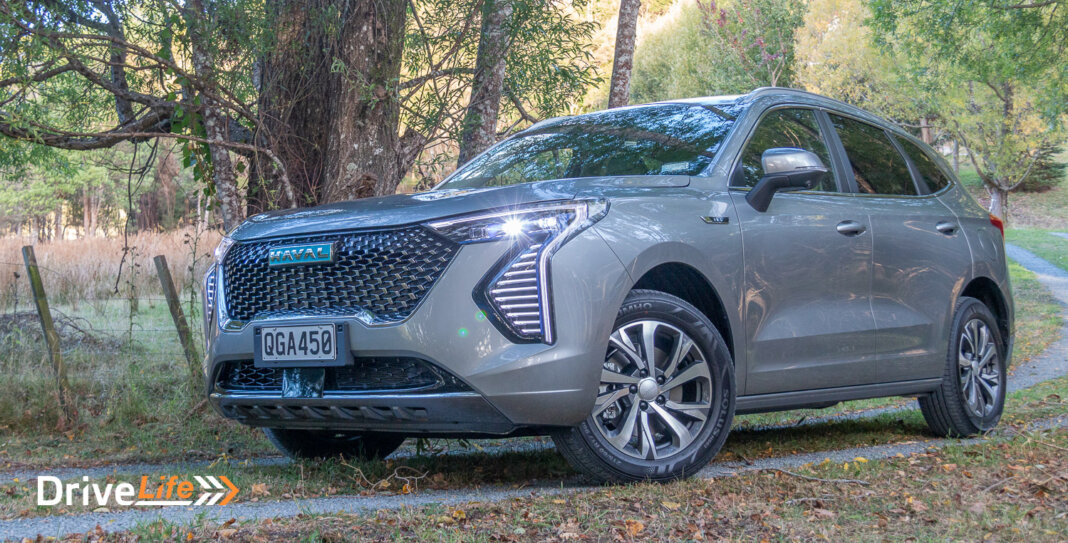The Jolion is the smallest SUV in the Haval range, first entering the New Zealand market in 2021. In 2022, a hybrid powertrain became available as an alternative to the petrol units in the two higher specification models, the Lux reviewed here and the higher-priced Ultra.
As is the norm, the hybrid models carry a price premium over their petrol-only cousins. The increase is at least $6,000 while offering to reduce the fuel consumption from 8.1 to 5.0L/100km. How does the hybrid perform in the real world? To find out, we tested this over a week of our regular daily drive, and longer highway journeys heading out of town over a long weekend.
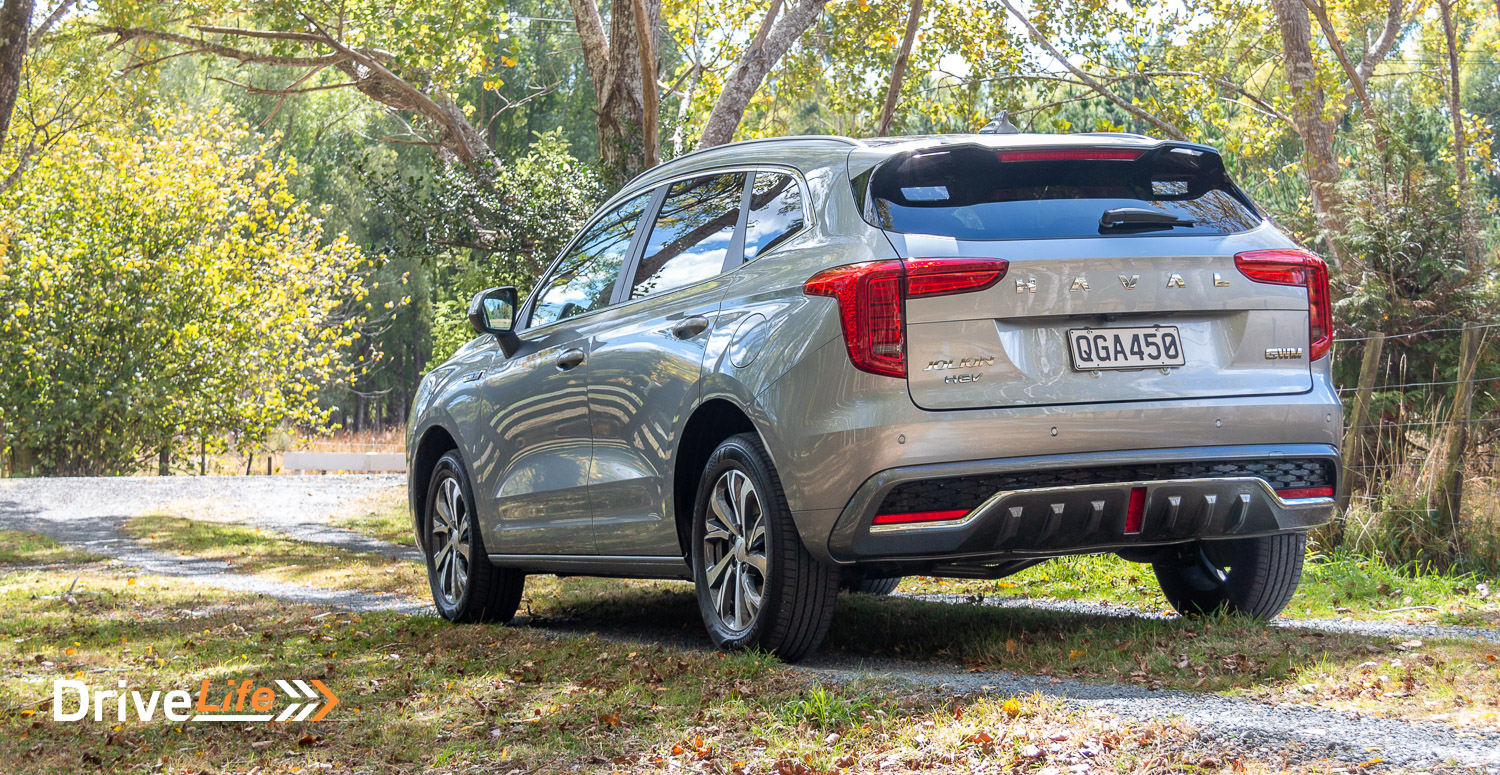
What We Like and Dislike About The 2023 GWM Haval Jolion Lux Hybrid
| What we like | What we don’t like |
| Overall design, especially the interior Interior fit, finish, materials Suite of safety features Road and wind noise well suppressed Ride and comfort Round town performance Very well featured Value for money | DHT gearbox Shallow boot space |
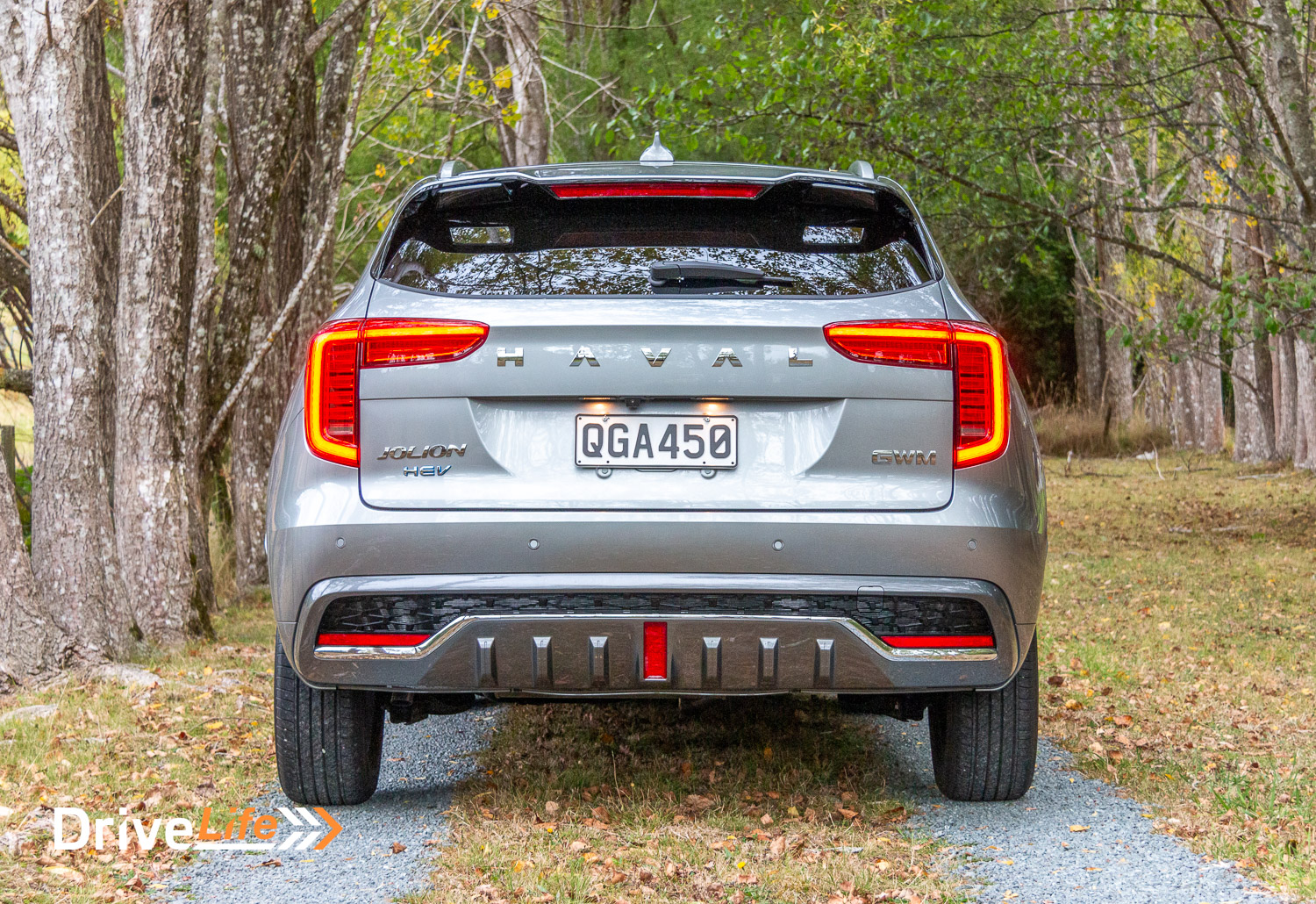
What’s In The 2023 GWM Haval Jolion Range?
The Jolion range has a total of five models, three petrol and two hybrids. All are front-wheel drive.
- Premium (petrol) $28,990
- Lux (petrol) $29,990
- Ultra (petrol) $32,990
- Lux (hybrid) $35,990
- Ultra (hybrid) $39,990
The petrol-only Jolion models all have the same 1.5-litre, 4-cylinder turbo-petrol engine producing a maximum power output of 110kW and 220Nm of torque. The engine is mated to a 7-speed dual-clutch transmission and is rated to achieve combined fuel consumption of 8.1 l/100km.
The hybrid versions produce a combined power of 139kW (electric motor 110kW, petrol 70kW), and a combined 375Nm of torque (electric motor 250Nm, petrol motor 125Nm). This non-turbo petrol engine has the same 1.5-litre capacity as the petrol-only models, but in the hybrids, the engine is mated to a DHT (Dedicated Hybrid Transmission). The combined fuel consumption is rated at 5.0 l/100km.
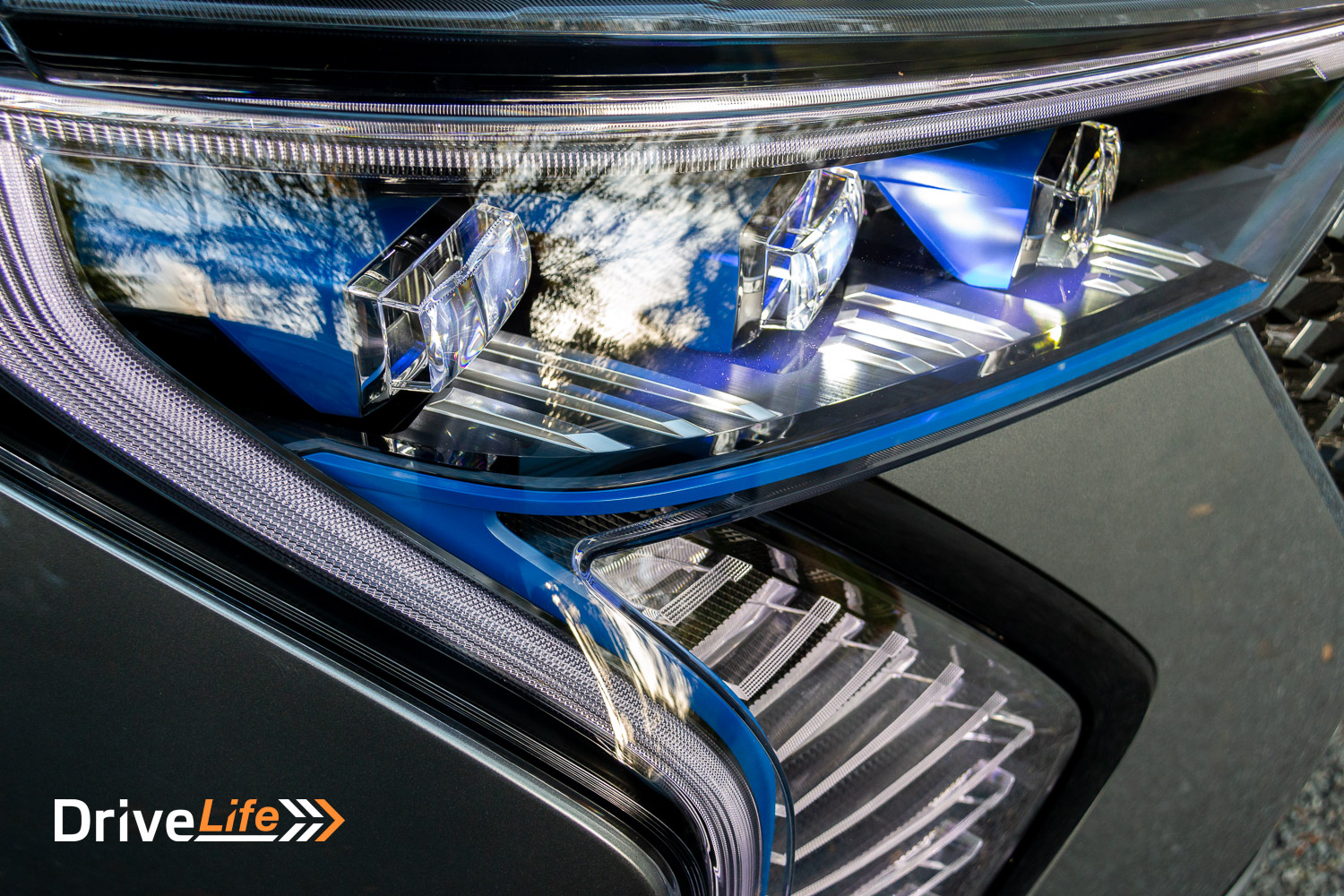
2023 GWM HAVAL JOLION Standard Equipment Highlights
The lowest specification level “Premium” is available with a petrol-only engine. The two higher specification levels, in increasing order, Lux and Ultra each have the same equipment irrespective of being supplied with either the petrol or hybrid engine.
As standard the Premium model gets:
- Keyless entry and start
- Burglar alarm and anti-theft immobiliser
- 17″ Alloy Wheels
- 3.5” full-colour instrument cluster
- 10.25″ colour multimedia touchscreen
- Apple CarPlay and Android Auto (cable connection only)
- Reverse camera
- Adaptive cruise control
- Lane departure warning + Lane keep assist
- Traffic sign recognition
- Roof rails
- Rear cross-traffic alert
- Paddle shifters (petrol-only models)
- Single-zone air conditioning
In addition, the Lux models get:
- 7.5” full-colour instrument cluster
- 360-degree camera
- 6-way electric adjustable driver’s seat
- Comfort-Tek faux leather accented seat trim
- Heated front seats
- Microfibre faux leather steering wheel
- LED headlamps, daytime running lights and rear fog lamps
- Electric heated and folding mirrors
- Rear privacy glass
- Automatic anti-glare rear-view mirror
- Driver window one-touch up and down
- Dual-zone air conditioning
In addition, the Ultra models have:
- 18” Alloy wheels
- Panoramic sunroof
- 12.3” colour multimedia touchscreen
- Wireless charging
- Heads-up display
- Four-door window one-touch up and down
- Key fob window-close function
All models have impressive warranties comprising a 7-year unlimited km vehicle warranty, 8-year unlimited km for the battery pack and 5 years Roadside Assist.
2023 GWM Haval Jolion Colour Range
There is no extra cost for any colour:
- Hamilton White
- Golden Black
- Azure Blue
- Smoke Grey
- Glacier Blue
- Mars Red
For a full list of specs and options available for the GWM Havel Jolion Lux Hybrid head on over to GWM New Zealand’s website
How Does The 2023 GWM Haval Jolion Lux Hybrid Compare To Its Competition?
The following vehicles fall into the same type of vehicle as the Jolion in being smaller SUV-style petrol hybrids, however, none really come all that close to the combination of features, performance and price offered by the Jolion.
| Make/ Model | Engine | Power/ Torque kW/Nm | Seats | Fuel L/100km | Towing Capacity kg | Boot Space, litres | Price |
| Suzuki S-Cross JLX Hybrid AWD | 1.4-litre, 4-cylinder turbo-petrol with hybrid assist | 95/235 | 5 | 5.9 | 600/1,500 | 430 | $45,990 |
| Kia Niro HEV Light | 1.6-litre 4-cylinder petrol hybrid | 104/265 | 5 | 4.4 | 600/1,300 | 425 | $44,990 |
| Toyota Corolla Cross GX Hybrid | 2.0-litre, 4-cylinder petrol hybrid | 146/190 | 5 | 4.1 | 750/750 | 428 | $42,990 |
| Toyota Yaris Cross GX Hybrid | 1.5-litre, 3-cylinder petrol hybrid | 85/145 | 5 | 3.6 | 400/400 | 390 | $38,990 |
| GWM Havel Jolion Lux Hybrid | 1.5-litre 4-cylinder petrol hybrid | 139/375 | 5 | 5.0 | 750/1,300 | 390 | $35,990 |
Please note that DriveLife does its best to ensure the information above is correct at the time of publication, however, prices, specifications and models can change over time. Please bear that in mind when comparing models in the comparison table.
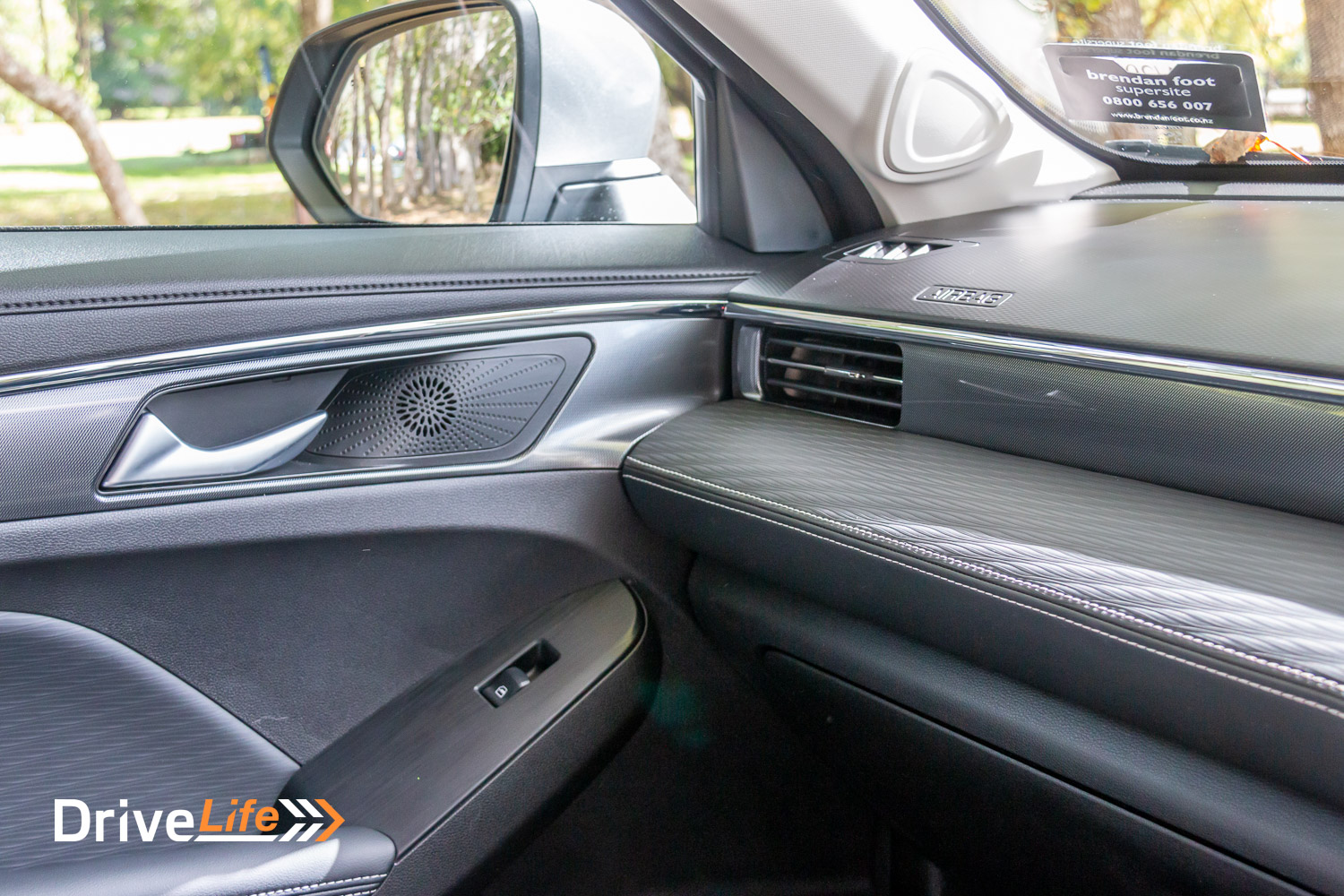
First Impressions Of The 2023 GWM HAVAL JOLION LUX HYBRID
Prior to my week with the Jolion, my only experience with Haval vehicles was noticing their increasing popularity on our roads. On collecting the Jolion, my first impressions were of a very impressive vehicle, all the more so because of the price. From the outside, it’s a fairly conventional-looking small-ish SUV. While it may be the smallest SUV in the Haval range its design and presence feels more mid-size. In fact, comparing it to the H6 that Fred is reviewing right now, it didn’t feel that much smaller.
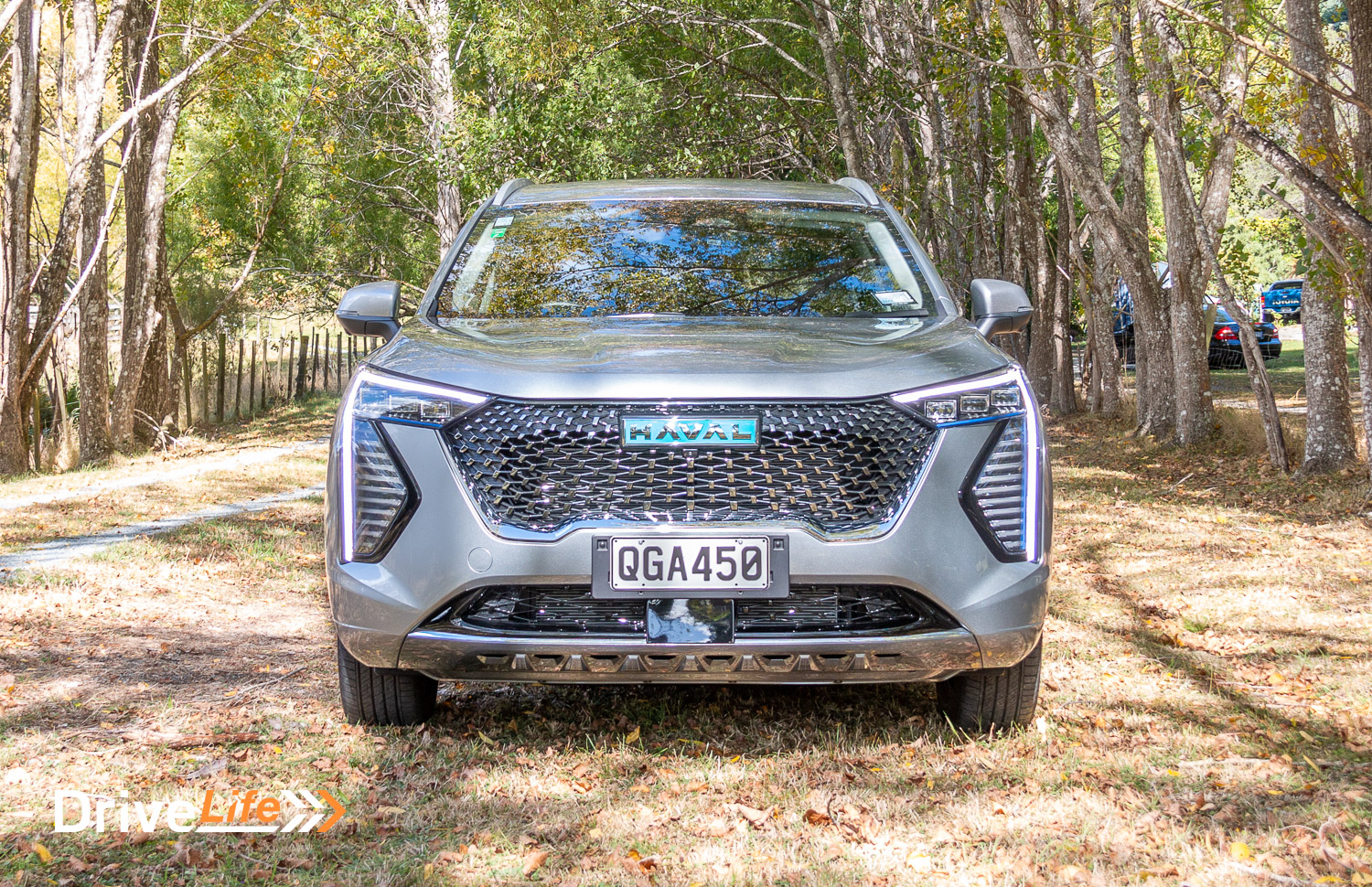
The front is dominated by a large protruding grille flanked on each side by very distinctive LED lighting installations, uniquely tying it into the family theme for Haval. An entertaining feature on first unlocking the car from the remote was the show put on by the front LED lights creating strobing patterns in orange and white. It was a little like the nighttime city illuminations of Hong Kong.
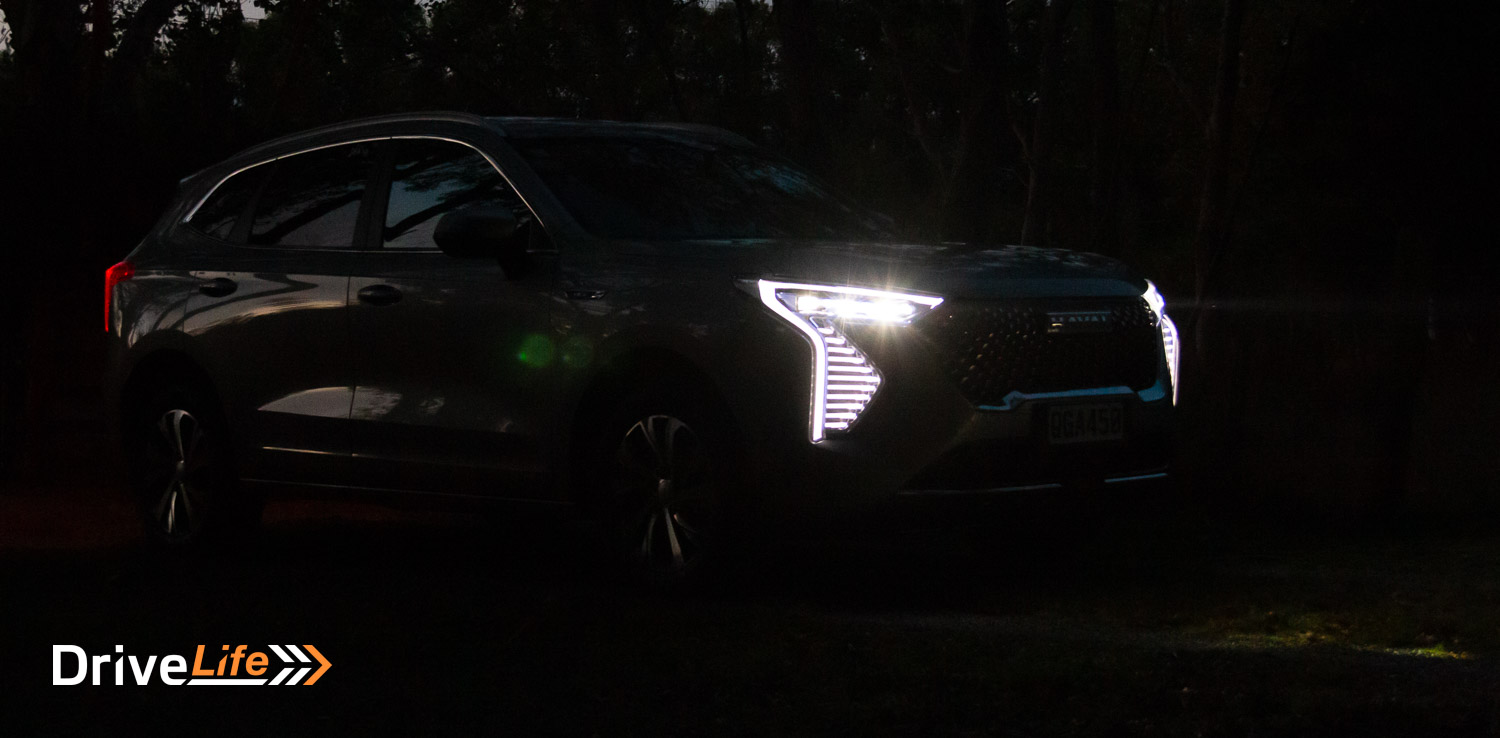
From the very first opening of the doors to the well-considered interior design and material choices, the car had the look and feel of a quality product well above its price position.
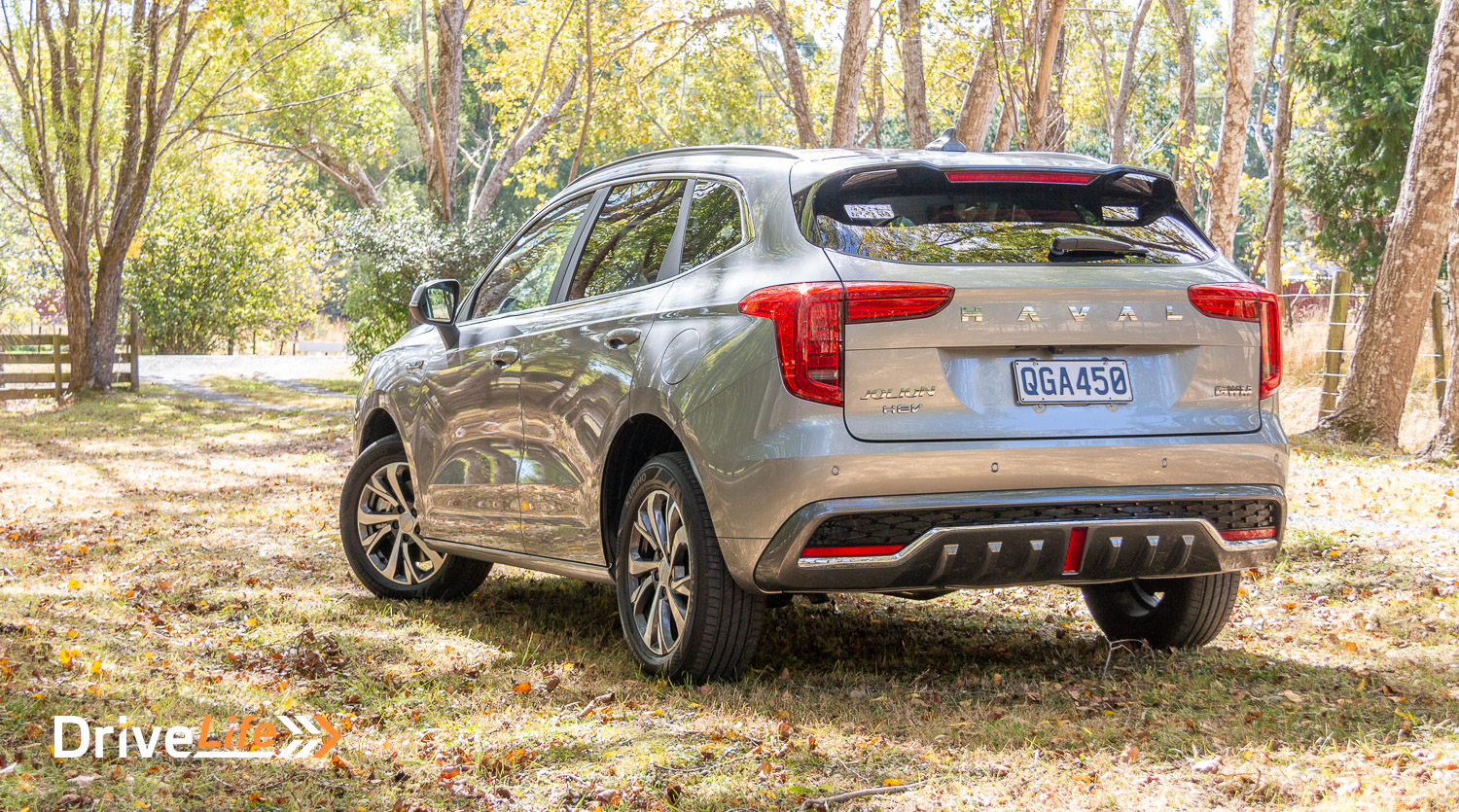
What’s The Interior Like In The 2023 GWM Haval Jolion Lux Hybrid?
The interior is truly a nice place to be and the overall appearance is sleek and uncluttered. Dark greys and black tones are used for the seats and interior surfaces. Lifting these is a restrained use of contrasting detail panels including chrome highlights. Above the window line, the pillars and roof lining are faced with light cream fabric giving the interior a light and spacious feel.
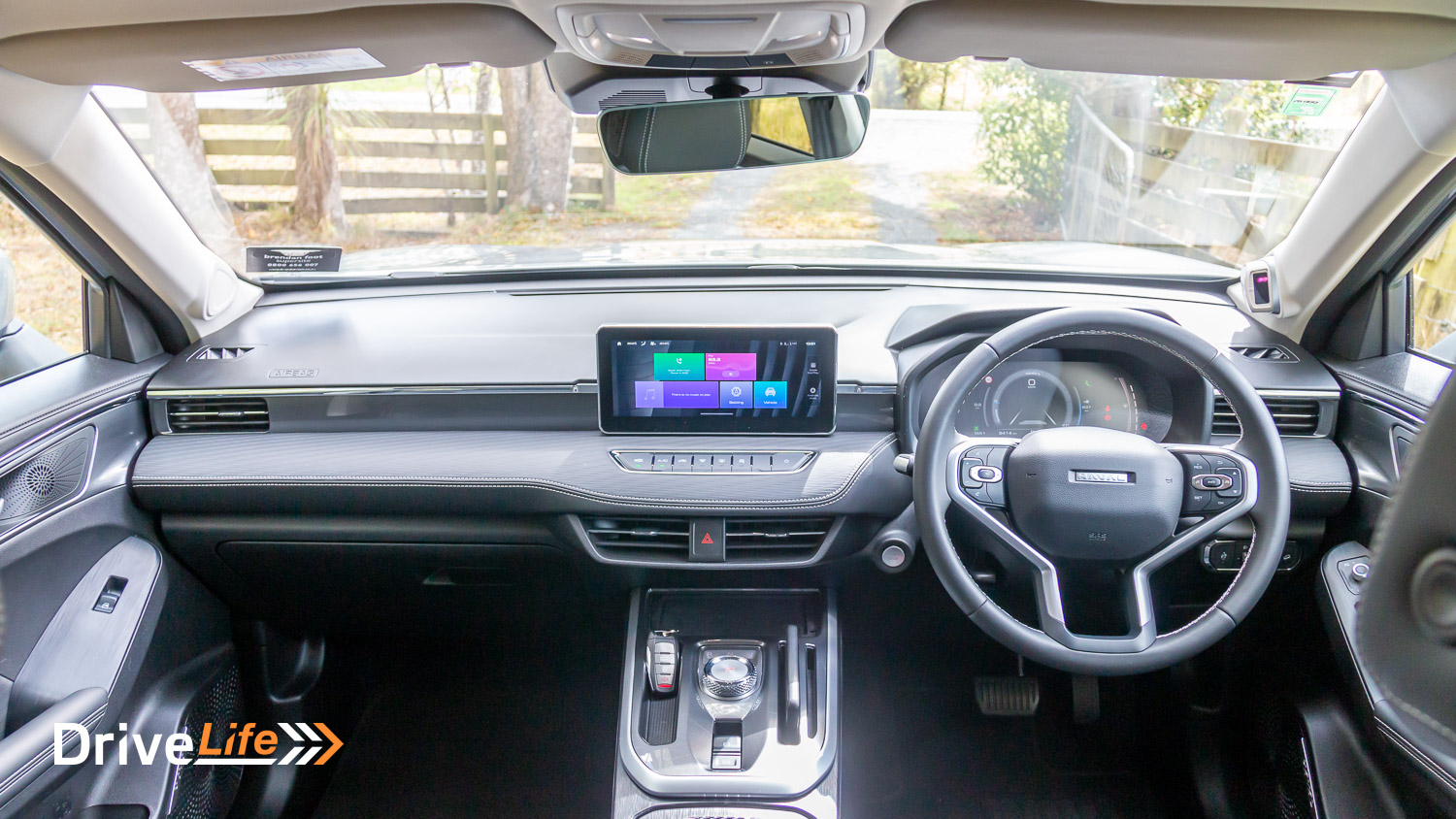
All the key touch-points of the interior – steering wheel, a dash capping around the ventilation controls and the armrests – are all soft-touch materials, all chosen well to maintain that quality feel and appearance. A nice feature was the elegant stitching pattern in a contrasting thread that was used around the inner rim of the steering wheel. Some of the details like those for the speaker facings and the centre console-mounted rotary automatic gear-selection knob are clearly influenced by those found in up-market European cars. These are sufficiently well executed to work well in the interior without looking like a shame-faced copy.
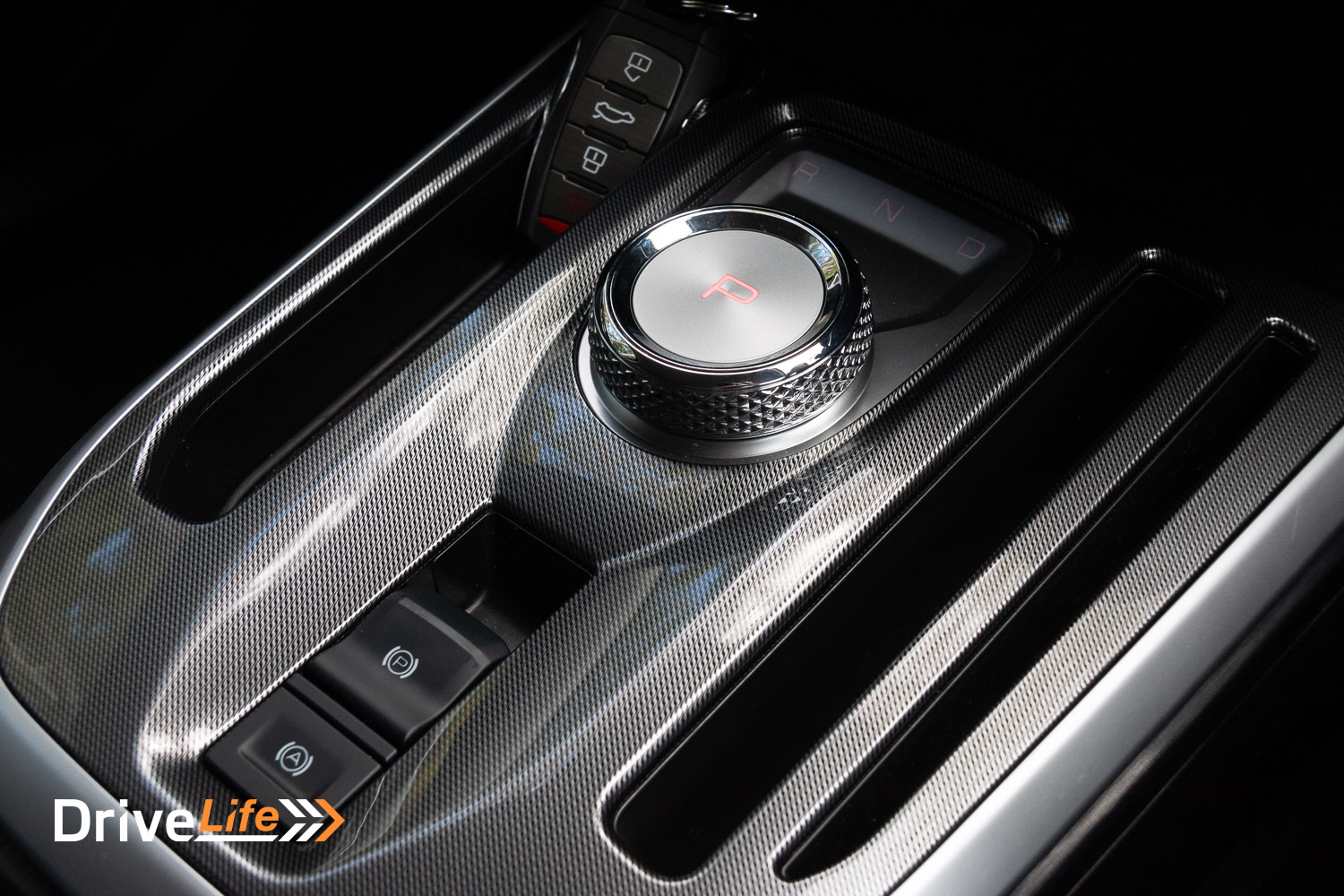
The faux leather accented seats are attractively detailed with a theme consistently applied to all seats in the car. The two front seats come with electric seat adjustment, six-way on the driver’s seat. While the driver’s seat adjustment was great, it was a surprise to find the steering wheel did not have telescopic adjustment, only height.
In the rear, there is good space for our two six-foot-tall boys without their similarly sized parents having to make compromises in their own seating space. The rear seats are split 60/40 and include a centre fold-down armrest with two cup holders. In addition to the cup holders, all four doors include provisions for holding larger drink bottles.
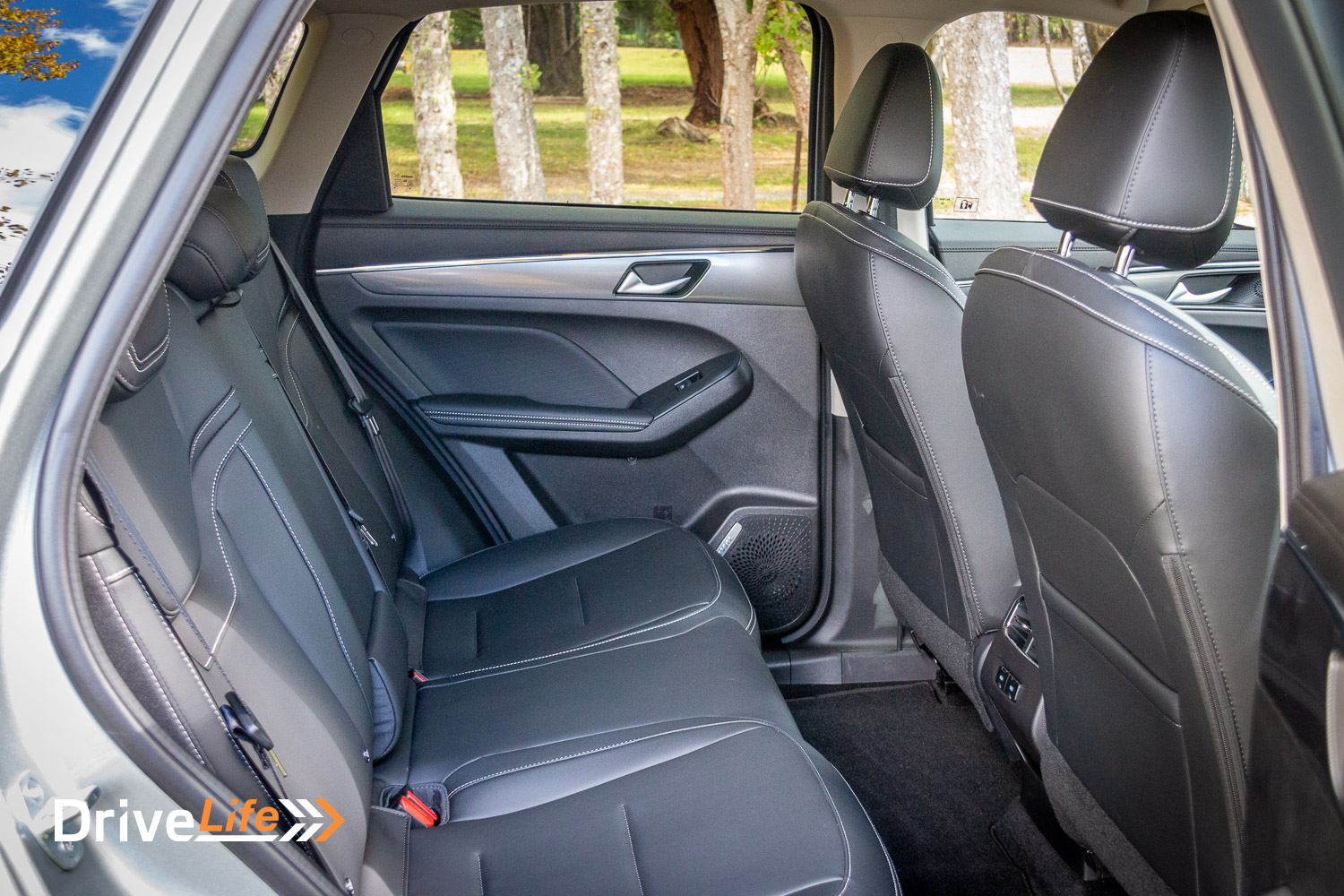
The instrument cluster is a clear digital screen which displays all key information. In the centre of the dash, the driver can choose to display various vehicle information sets, however, these options appear to be overridden should you have the lane departure system operational. On start-up, the first illustration on the dash displays the tyre pressures and temperatures for each tyre; a nice touch adding to the safety features. Around the screen, some of the icons and text are rather small, requiring more than just a glance to take in the details. Once familiar with the information locations this should not be a problem.
The centrally mounted infotainment unit is an adequate size, clear and very responsive to the touch. It provides access to all manner of settings and controls. Fortunately, fingerprints did not mark it too badly – bonus. One of the first actions was to Bluetooth my phone, a very straightforward exercise and somewhat essential as navigation services are only available via Apple Carplay or Android Auto. I can confirm that this worked very well and the integration was faultless.
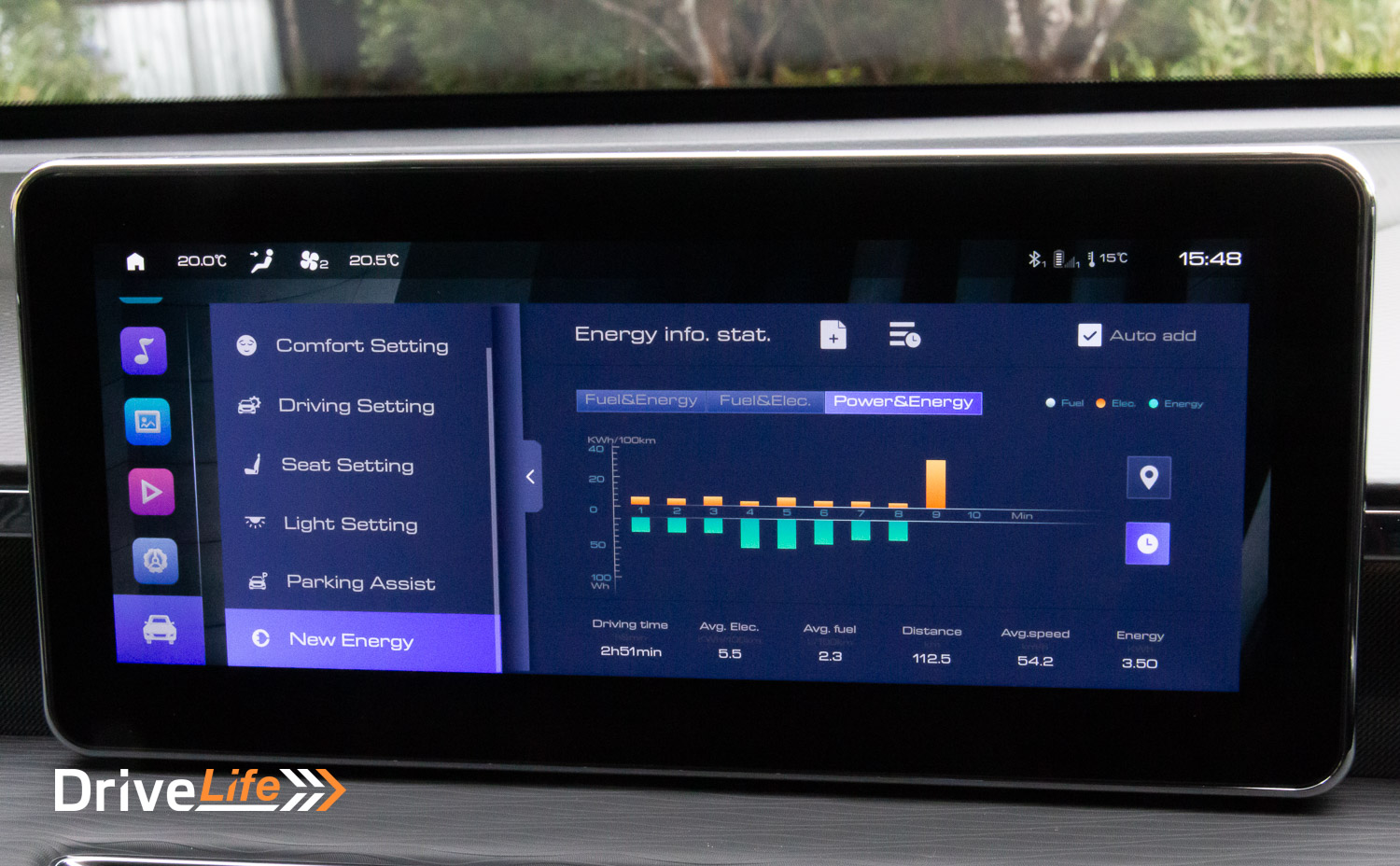
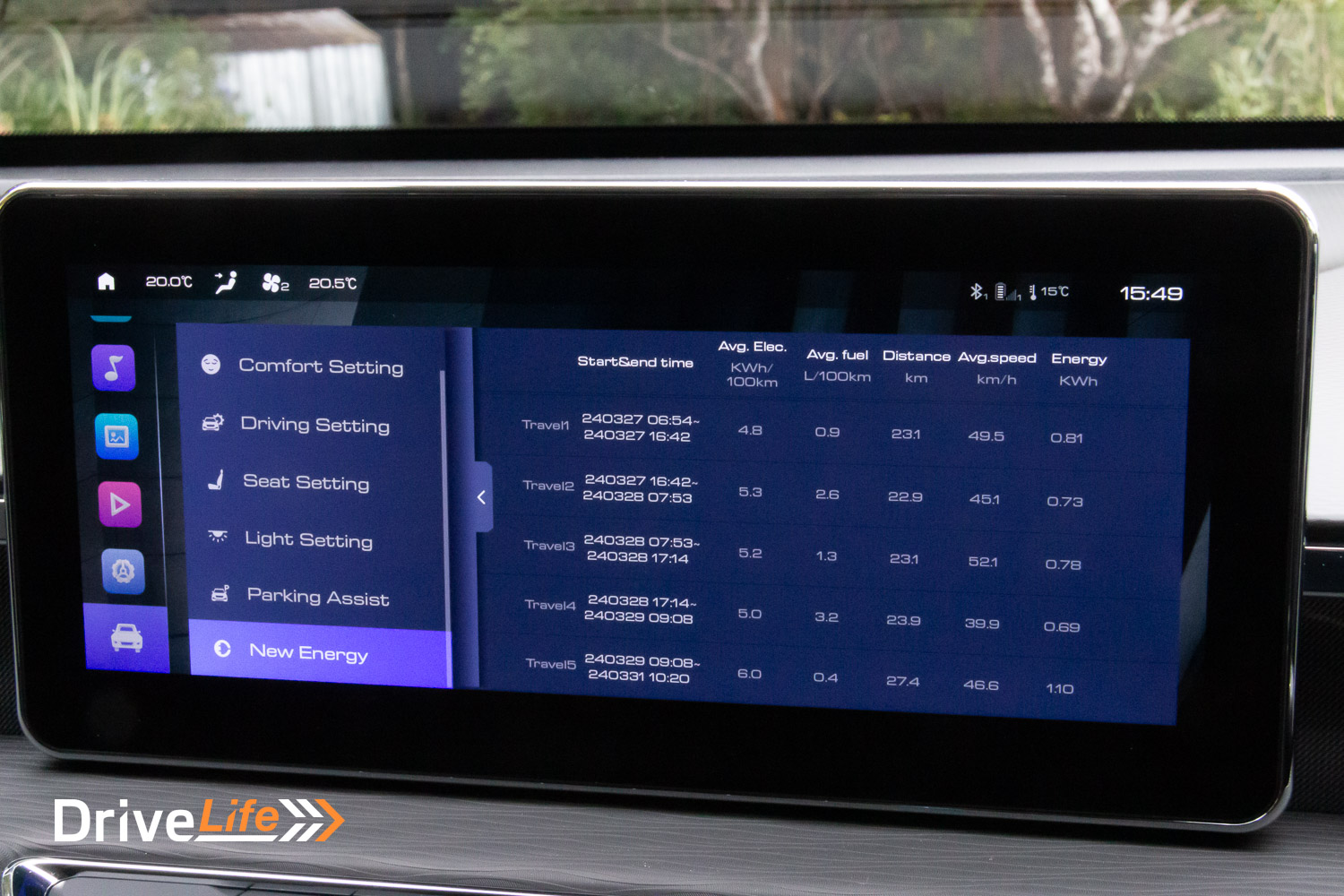
A set of buttons located below the infotainment screen offers a sub-set of controls for key functions of the ventilation and air-con system and includes a quick link to display the car cameras. It also has a button to turn the screen off if required – could be useful for night driving. Vents for directing air to the passengers were stylishly located across the dash for the front passengers and more functionally located in the back of the centre console for those in the rear.
The automatic gear selection controls are located on top of the centre console. It comprises a silver rotary knob at the centre of which is the “P” park function, simply turning the knob (any number of clicks) to the right selects D and to the left, R. Initially it seemed imprecise but quickly became intuitive, spinning it right or left to choose the drive direction. To each side of this were various storage recesses for the likes of phones, pens, keys and drinks, the latter offering two size options. Under the centre armrest was another decently sized storage box, large enough for a SLR camera.
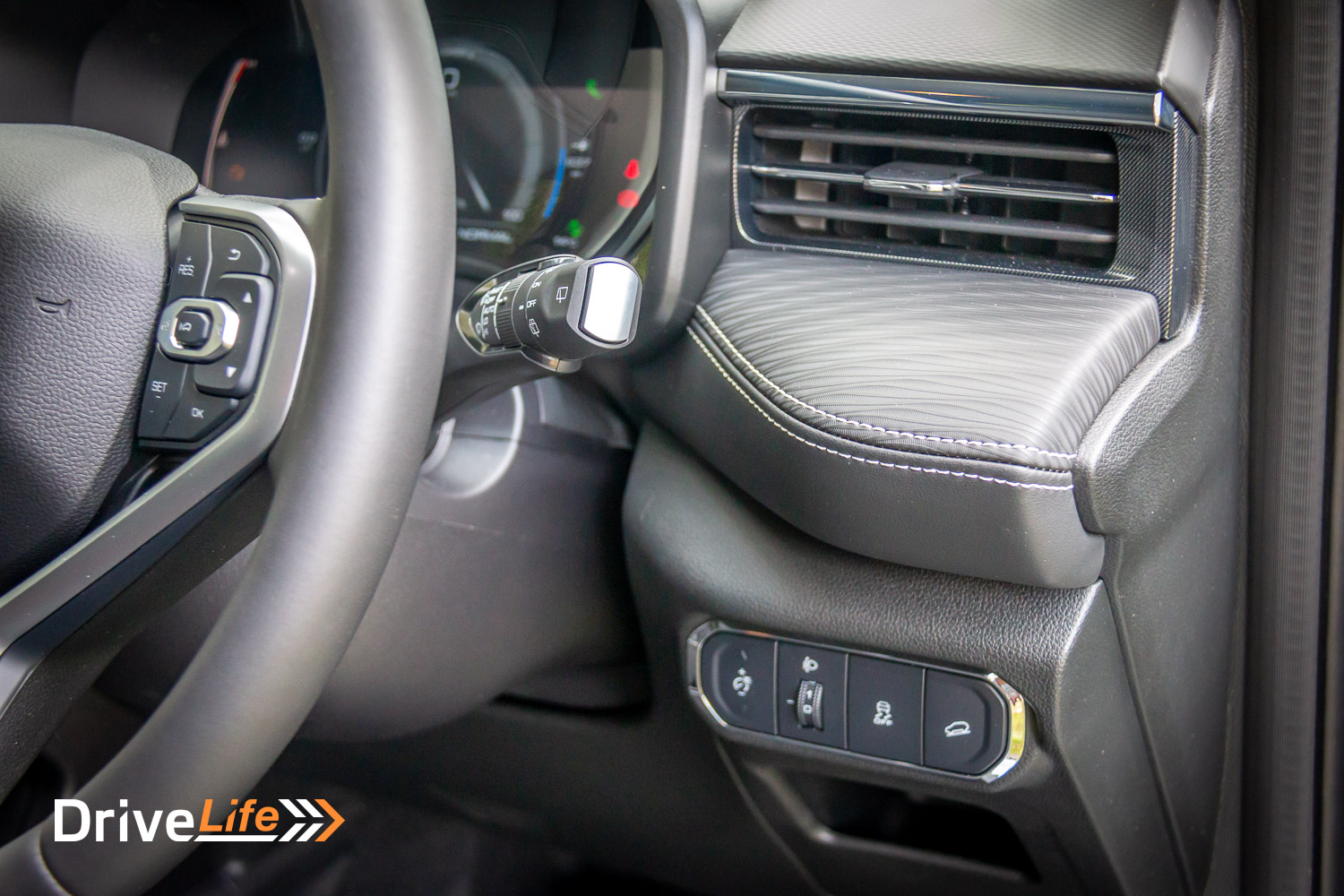
Beneath the centre console, there is an open-sided storage location. Here there are two USB-A ports, the top one dedicated to Apple Carplay/Android Auto phone connection. Cables plugged into these can be passed up through a well-placed hole to the phone tray location in front of the gear selector. While the phone tray does not include wireless charging in the Lux version, its design and mat kept phones secure while driving. Two more USB-A ports were located in the back of the centre console for the rear seat passengers.
One smart feature I have not seen very often was the inclusion of a USB-A power socket into the side of the interior rearview mirror mount. This was a perfect location for powering a forward-facing traffic camera. More cars should be doing this.
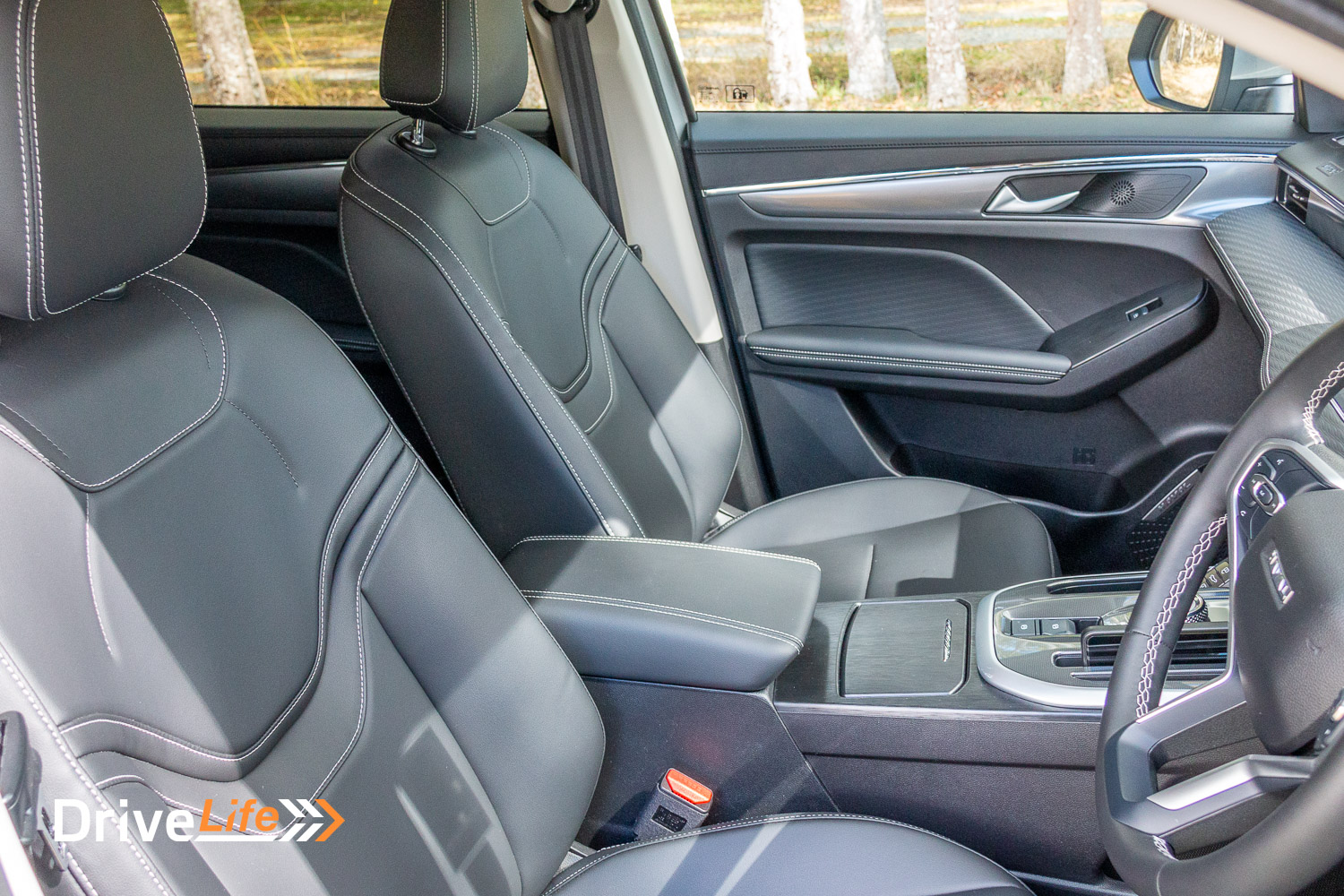
While it is a “small” SUV, the load space is surprisingly shallow. Access is good and so too is the load height, however, for the apparent “family size” of the car, it is on the small side. For the record, the boot capacity is rated at 390 litres with the seats up and 1,069 litres with the seats down. This is down on the petrol-only models which without any batteries have 430/1,130 litres seats up/down respectively. The rear seat backs can be lowered in the common 60/40 split or both and provide an almost flat floor through to the backs of the front seats. Occupying the sub-boot floor area are the main engine 12-volt battery, the flat tyre recovery pump and the repair kit, all securely mounted within a rigid foam moulding. The tyre repair kit negates the need for a spare tyre.
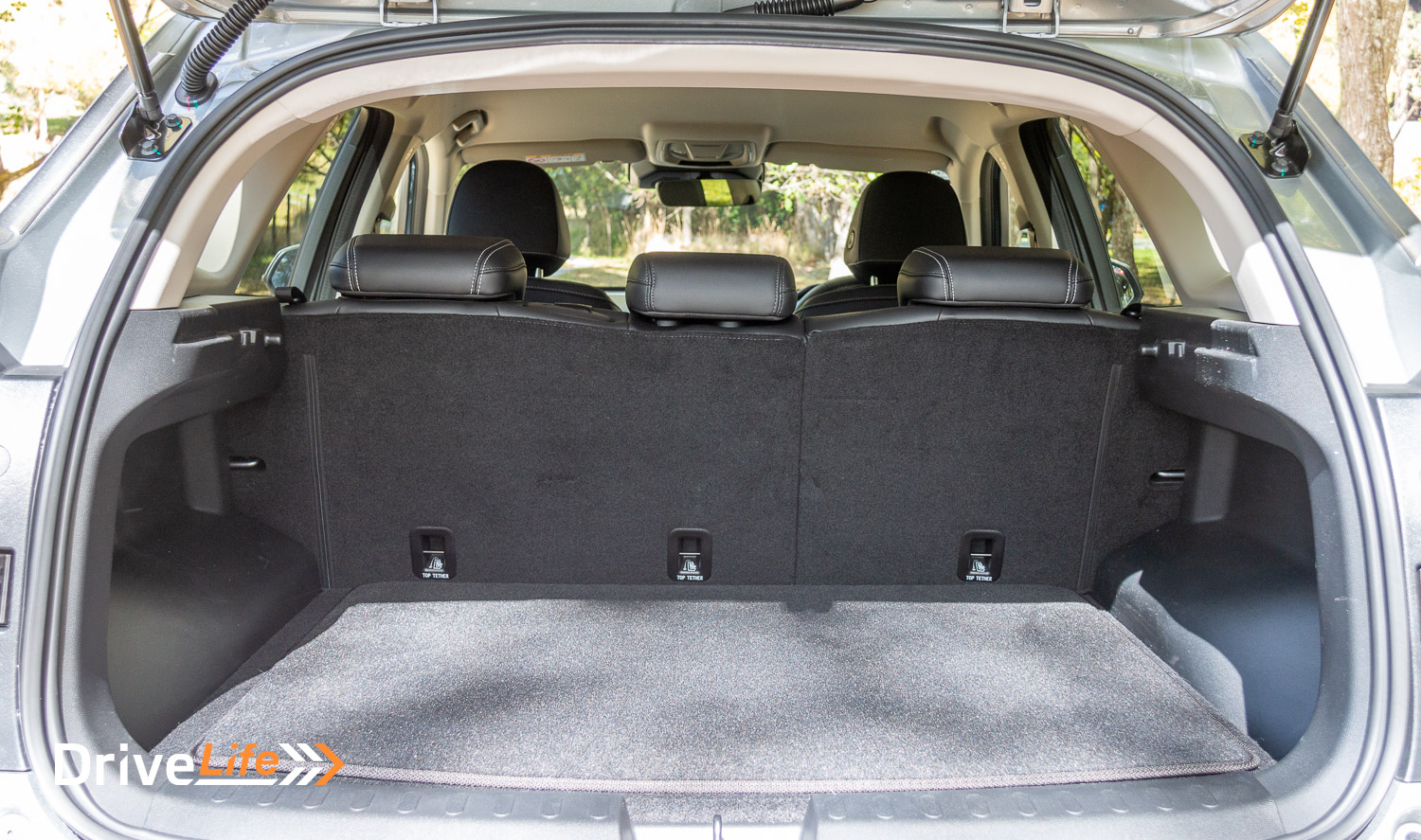
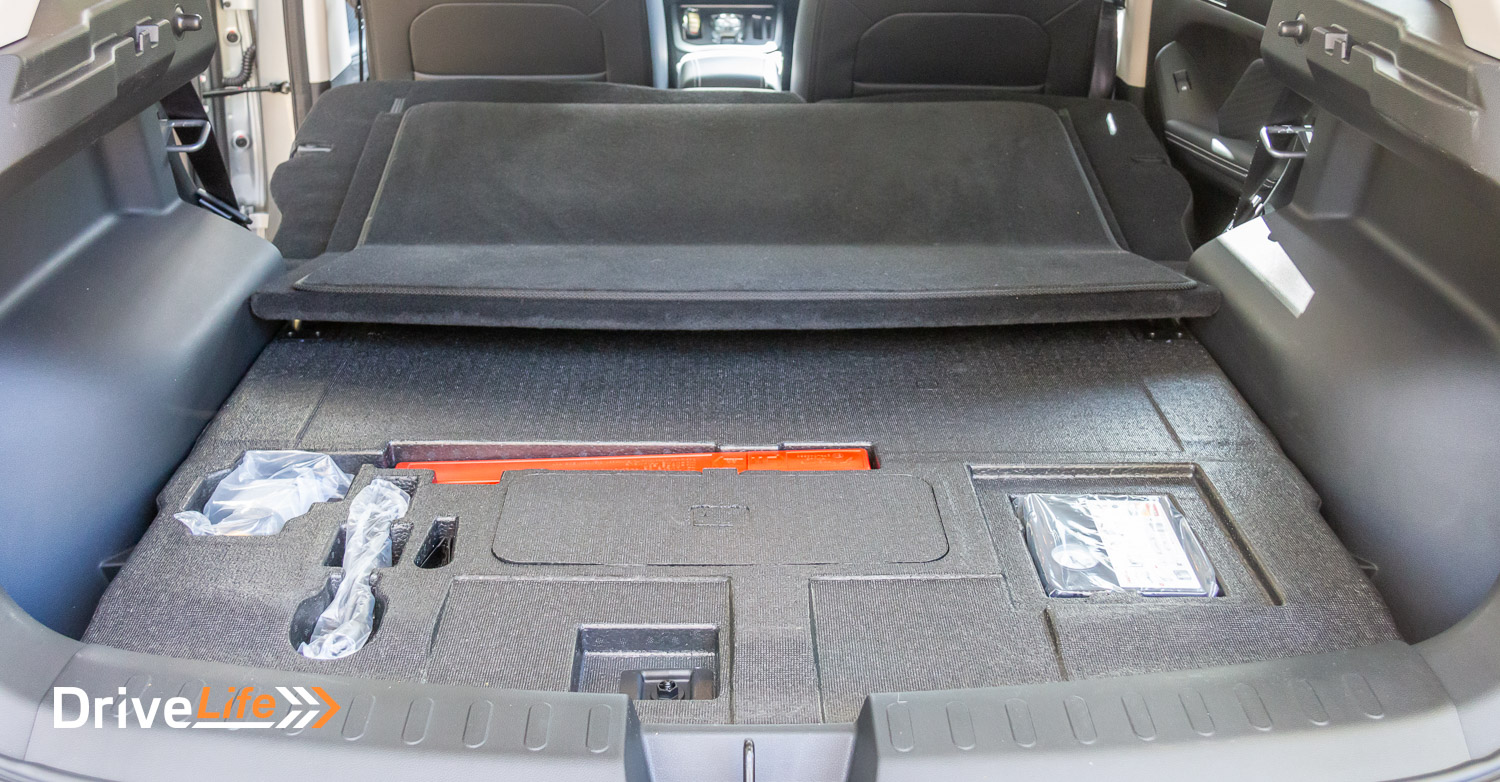
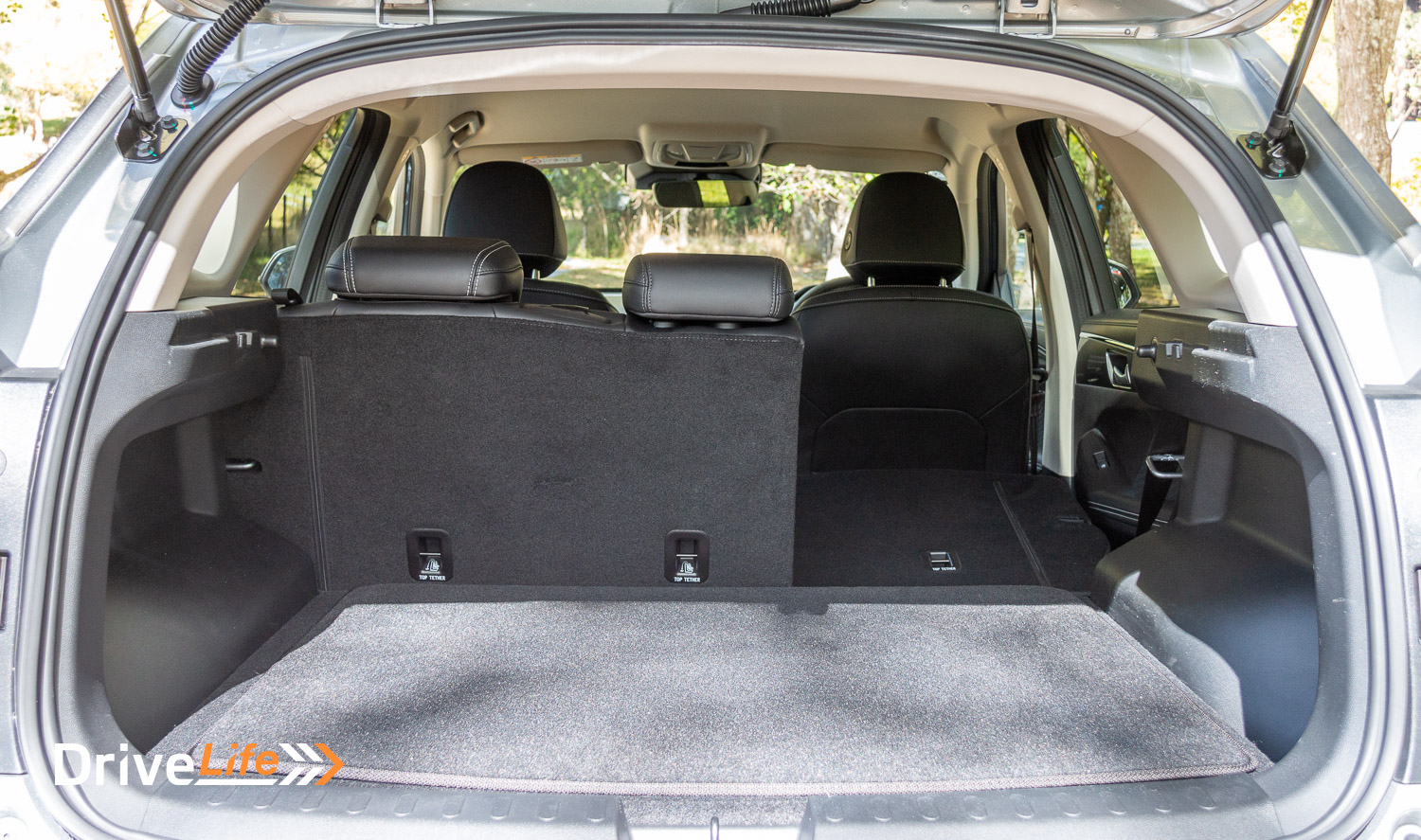
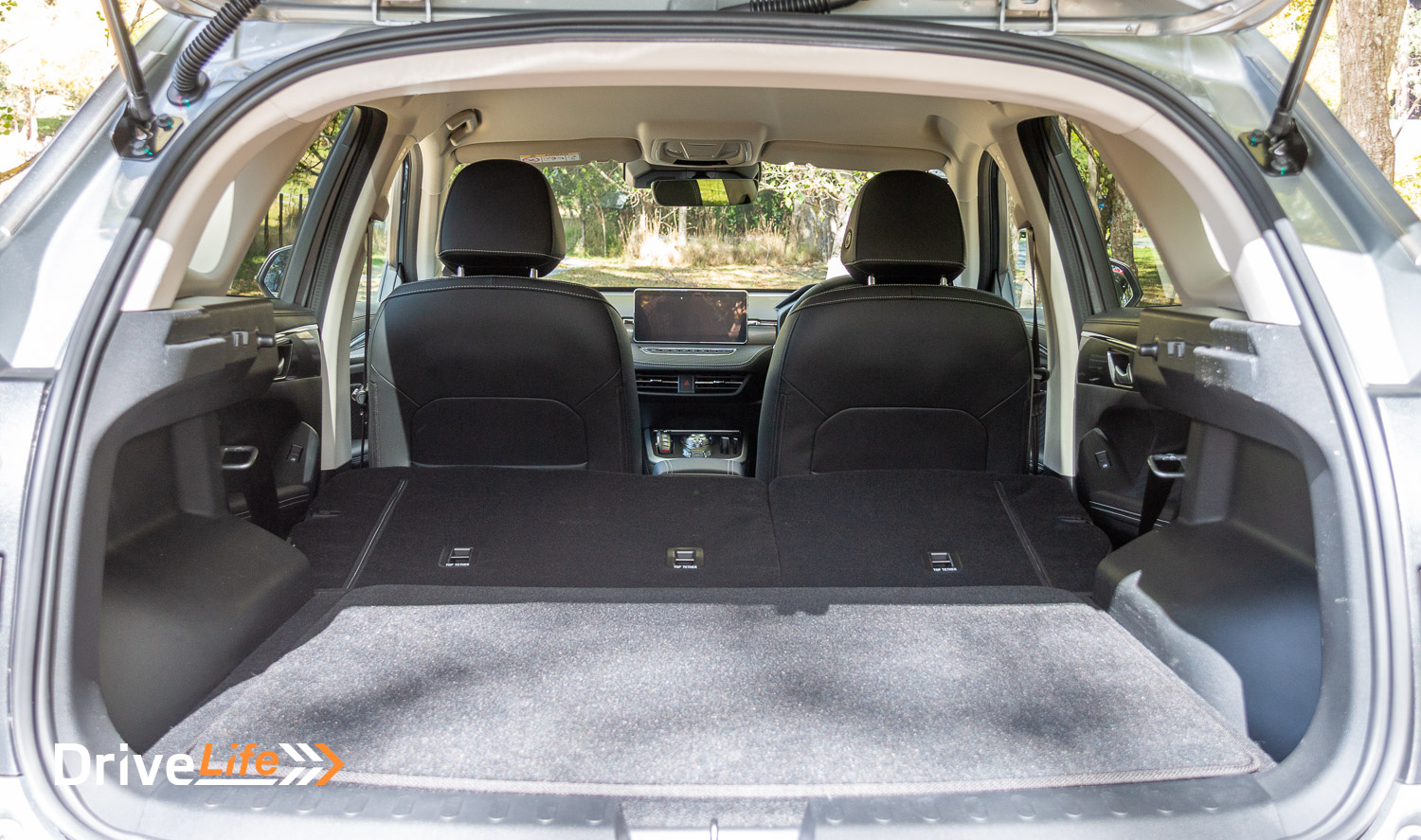
What’s The 2023 GWM Haval Jolion Lux Hybrid Like To Drive?
The Jolion is a very easy car to live with, being very well-specified for comfort and safety. We used the car as our regular transport for a week; commuting, shopping, and a decent out-of-town day trip. Over the week, we drove some 400 km and in all these situations it performed well. Being a hybrid, around town, it often starts silently in electric mode with the petrol engine added almost imperceptibly as required and to charge up the battery. If you require quicker acceleration, both engines are used to deliver decently rapid progress. All standard non-plug-in hybrid stuff, and it worked seamlessly; you just drive it.
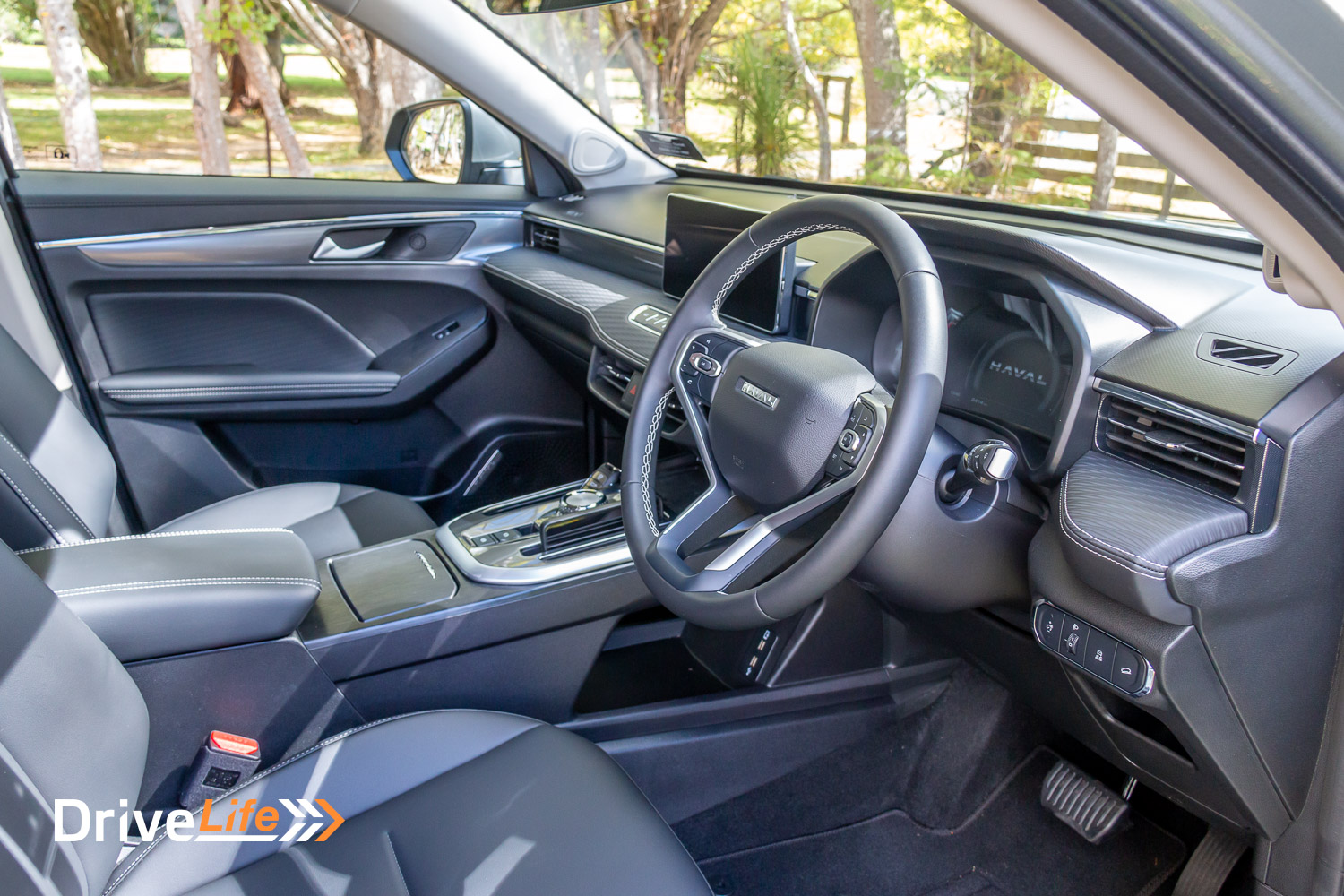
The main purpose of a hybrid is to save petrol. On collecting the car the petrol tank showed full and the indicated range was an impressive 988 km. After our 400 km week, the fuel gauge had reduced by only 3 of the 8 bars and it estimated the remaining range to be almost 500 km. Very impressive given the car’s 55-litre fuel tank.
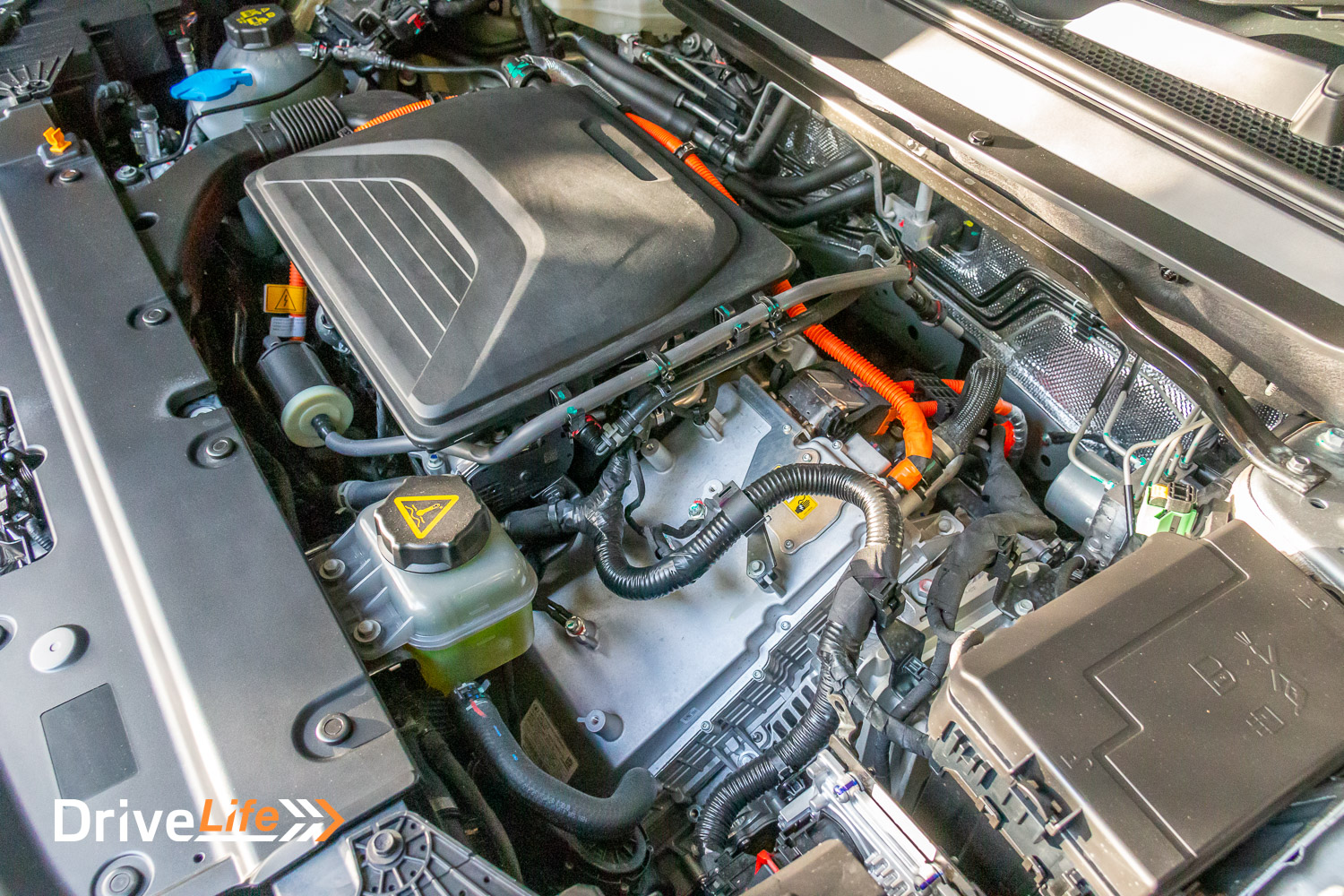
Visibility is good everywhere with the exception of the rear three-quarter view, which is partly obscured by the smaller rear side window and the large “C” pillar. However, the blind spot/cross-traffic detection systems, good mirrors and the excellent picture quality from the 360-degree camera set-up make this a non-issue.
If I had a criticism about driving the Jolion Hybrid it would relate to the DHT (Dedicated Hybrid Transmission). It seemed to behave like a CVT transmission where the petrol engine would rev out to either accelerate the car or at times simply to maintain a constant speed on a long dragging climb up a hill. So it was with some reservation that we took it for a longer drive over the Remutaka Hill road to the Wairarapa. Those reservations proved unfounded. While there were a few occasions when it simply revved out, in large part when I asked for keen acceleration to overtake on the short passing bays, it delivered a solid and effective increase in speed to get the job done quickly and efficiently. It could be surprisingly quick.
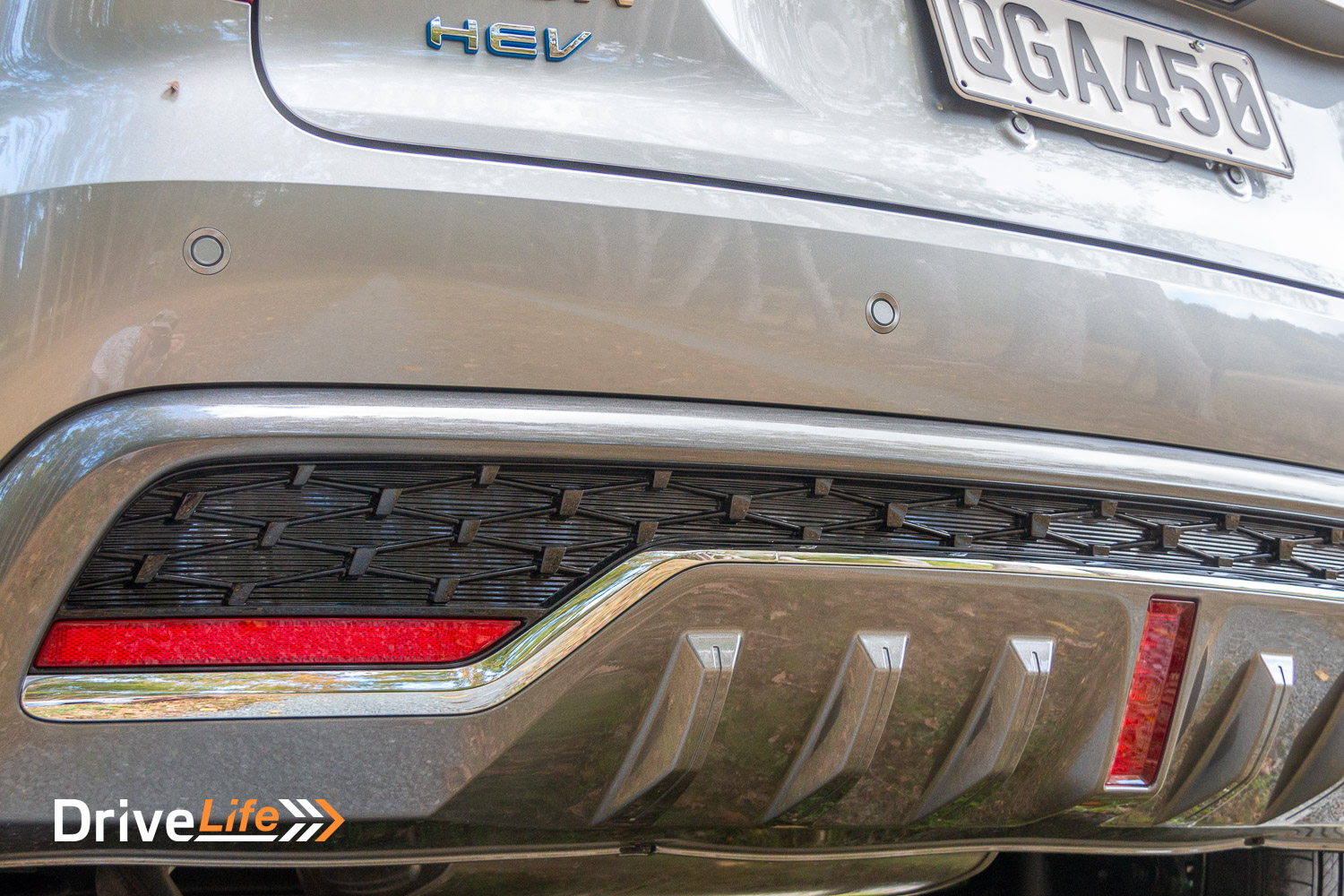
The general road holding and handling are predictable. Road irregularities are well-damped and did not upset the car or its occupants. Even over the worst of our suburban roads, it performed well and there were no squeaks or rattles. Wind noise too is well managed, with only the occasional wind gust inducing a small amount of noise around the front door frames. In summary, the interior is well insulated from a range of exterior conditions and road surfaces from coarse chips to a section of gravel road.
The steering wheel has all the usual controls for music/phone on the left, and adaptive cruise on the right. These all worked extremely well. These buttons on the wheel were the only physical buttons to control the volume of the entertainment and phone calls. Other controls for this were located within the infotainment screen. Behind the steering wheel, stalks for wipers and lights were located European style with indicators on the left.
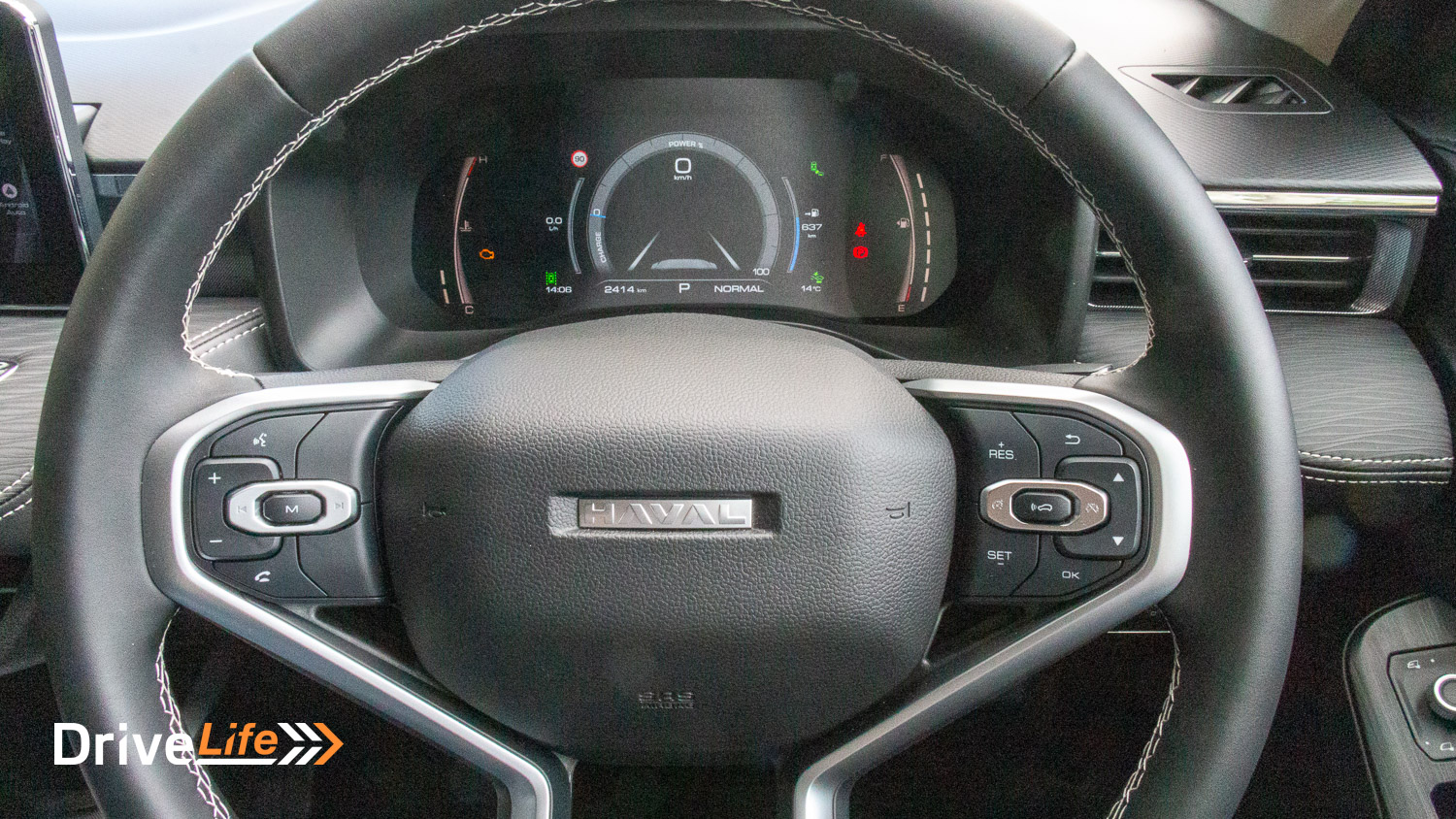
The adaptive cruise generally worked well, able to slow to a stop, then requiring a press of the Resume button or the accelerator to start. When the traffic in front was slowing or had stopped, there were a few times I felt the adaptive cruise control started slowing the car later than I was comfortable with. Adjusting the gap interval to the maximum did not seem to change this. On a couple of occasions, the adaptive cruise mistakenly responded to parked vehicles at the side of a road even when the road was wide enough on each side. It was rather alarming to have an alert and the brakes be applied, albeit briefly for no actual hazard.
The infotainment screen is central to so many functions of the car. Oddly, the Home button is located in the top left corner of the screen, quite a reach for the driver. The design and layout of both the infotainment and instrument cluster screens are clean, stylish and attractive. Part of the style comes from the choice of font. While it looked good, the square form of the letters made it somewhat difficult to scan and read in a quick glance – not so helpful once on the move.
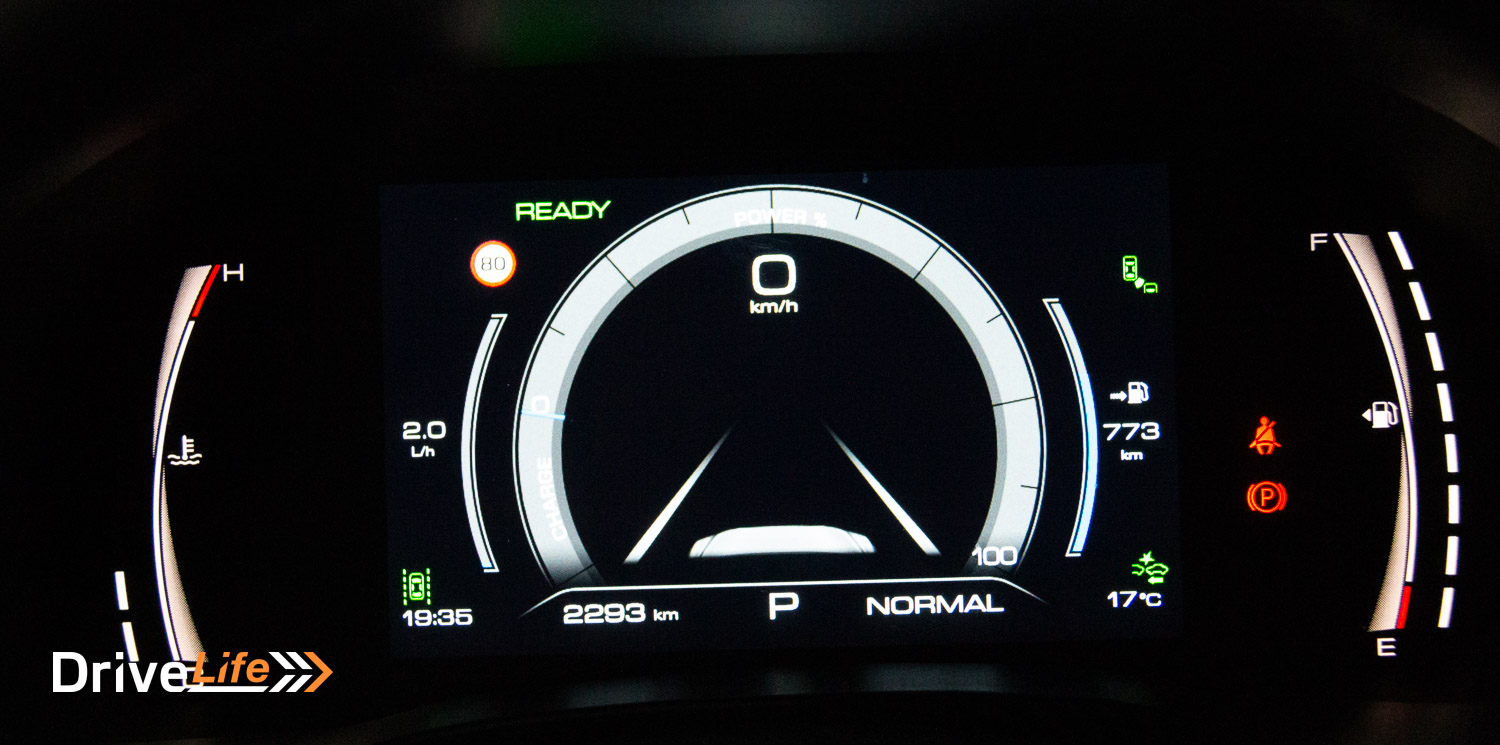
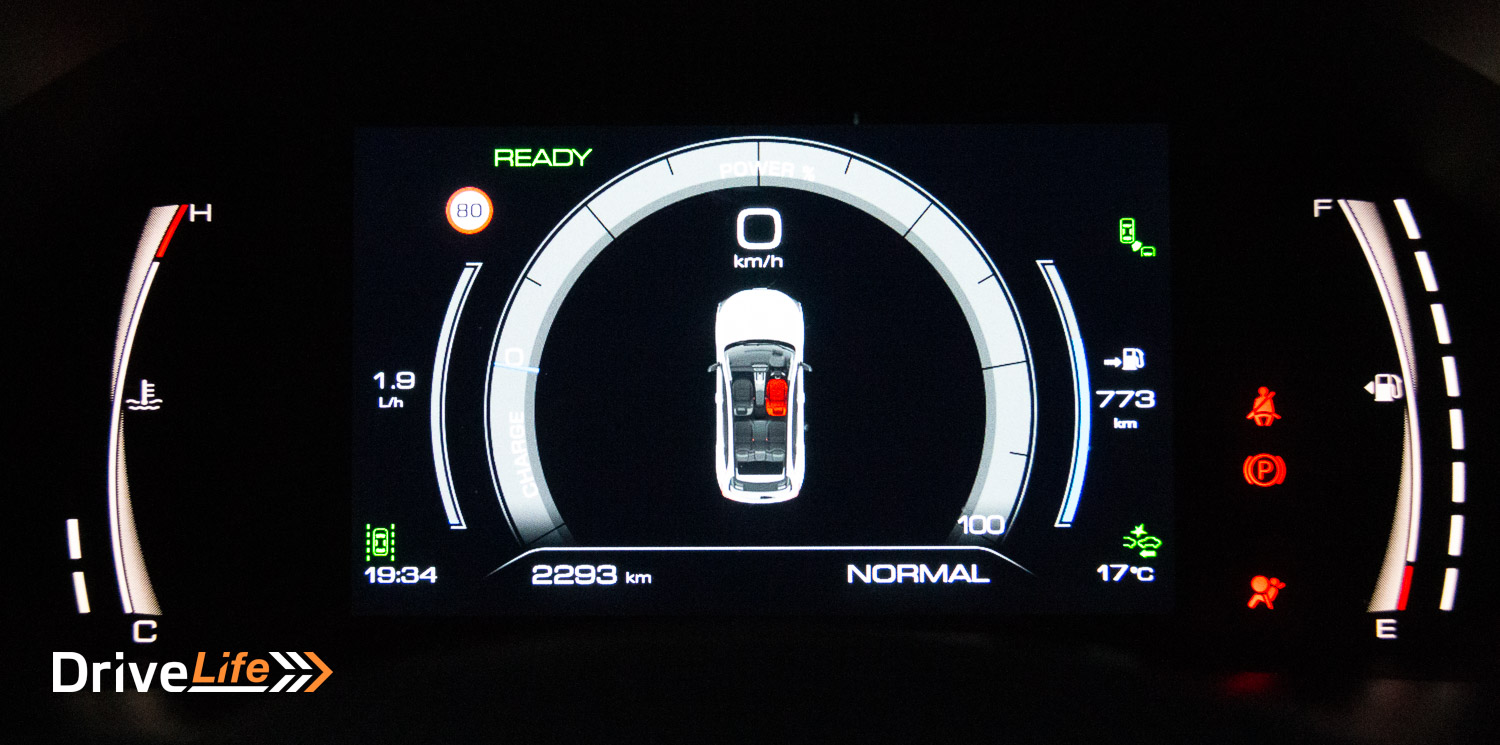
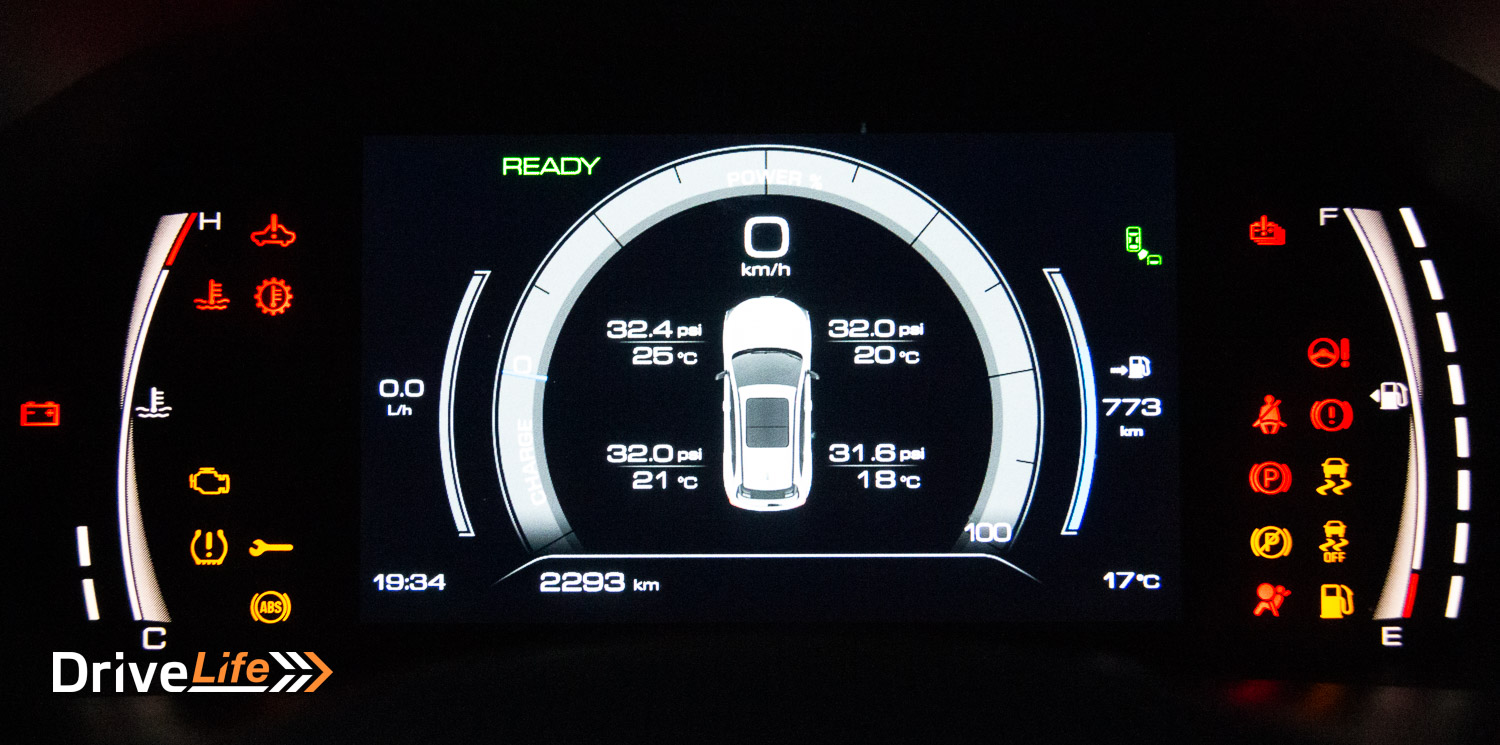
One function deep within the menus for the vehicle drive setting is a rather rare but brilliant option for a hybrid; Single Pedal Driving mode. Many 100% EV cars have this feature and having got used to it, I really like driving this way. To be fair, it’s not exactly the same as in an EV as it is not capable of bringing the car to a complete stop – the brake pedal is still required for that. However, when it came to driving the Remutaka Hill Road, the single-pedal option provided a useful amount of “engine braking” effect, so much so that I rarely needed to touch the brake pedal. This greatly assisted and simplified the drive. This, together with the rapid acceleration available for passing, made for a very satisfying drive. After finding the one-pedal setting, I left this activated for the remainder of my time with the car. It was great for all driving, regenerated power and I was pleased to discover this was one setting that remained selected on restarting the car.
Another feature that remained selected on the restart is the Auto-Hold handbrake – brilliant, and I wish all cars adopted that logic.
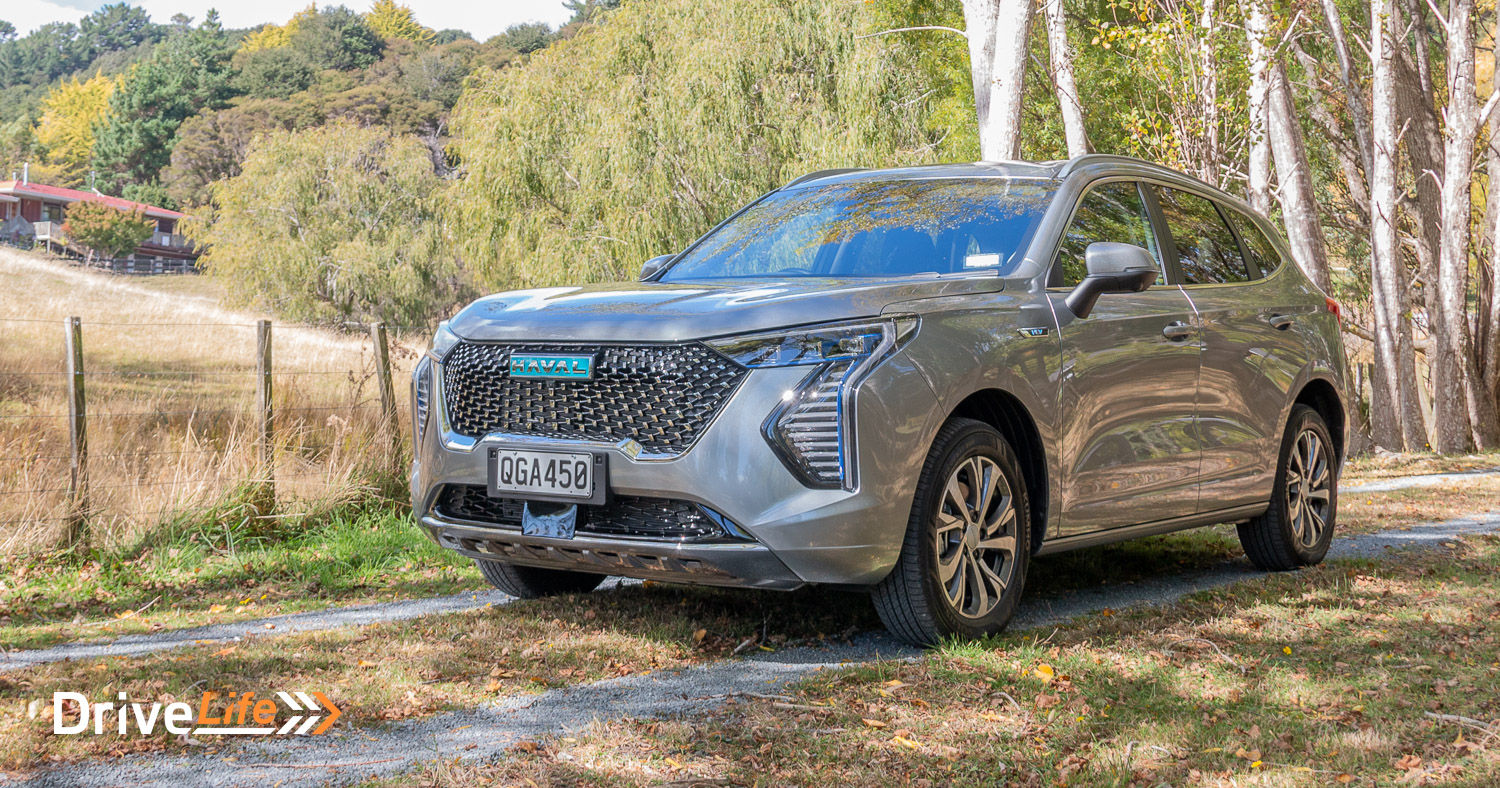
One of the safety features is a “fatigue” monitor informed by a camera mounted on the A-pillar looking back at the driver. Its function seemed well moderated and over the week I triggered it a couple of times, one of those was deliberately to test it. In response, I would see a warning screen on the infotainment “Don’t stray” beneath which were two buttons with options for “Yes” or “No”. Curious.
In keeping with the times, the proximity of the key fob is used for keyless entry and keyless starting. While keyless starting was faultless, the keyless entry was very intermittent. Most times a press of the key fob was needed to unlock the car.
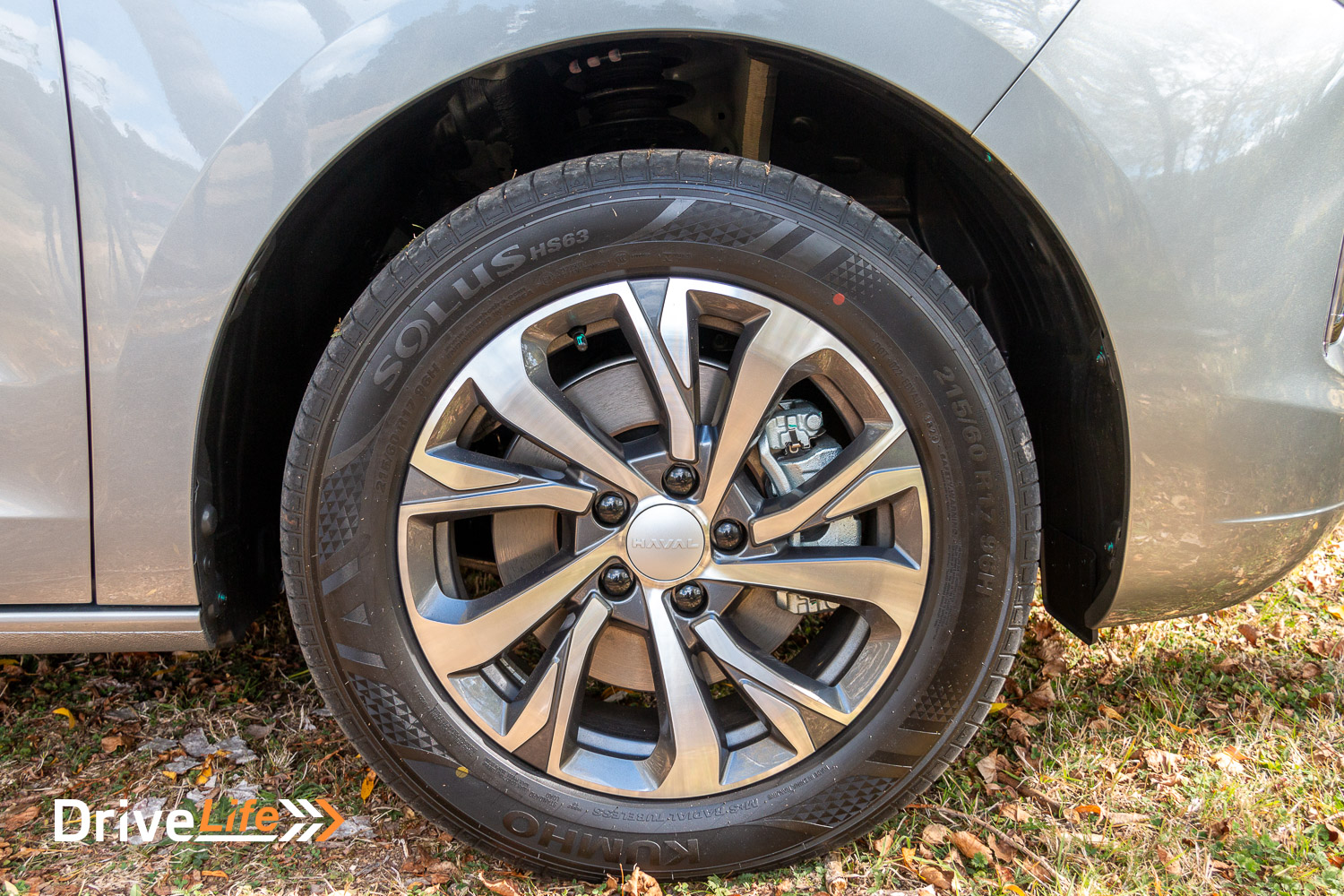
My last action with the car was to remove the cable to my phone for Android Auto. This sent the infotainment software into a spin and a screen came up “restart car to activate”. This action did solve the problem, but it was a little surprising.
Unfortunately, we were not able to determine the exact fuel efficiency over our time with the car as the trip meter seemed to be limited to single trips, resetting the next time the car was started. However, diving into the car’s menus, we found that over the approximately 2,500 km the vehicle had covered, the average fuel consumption was 5.9 l/100km. Being a test model, this would suggest that in the real world of life as a family car, approaching the claimed economy of 5.0l/100km is not unrealistic.
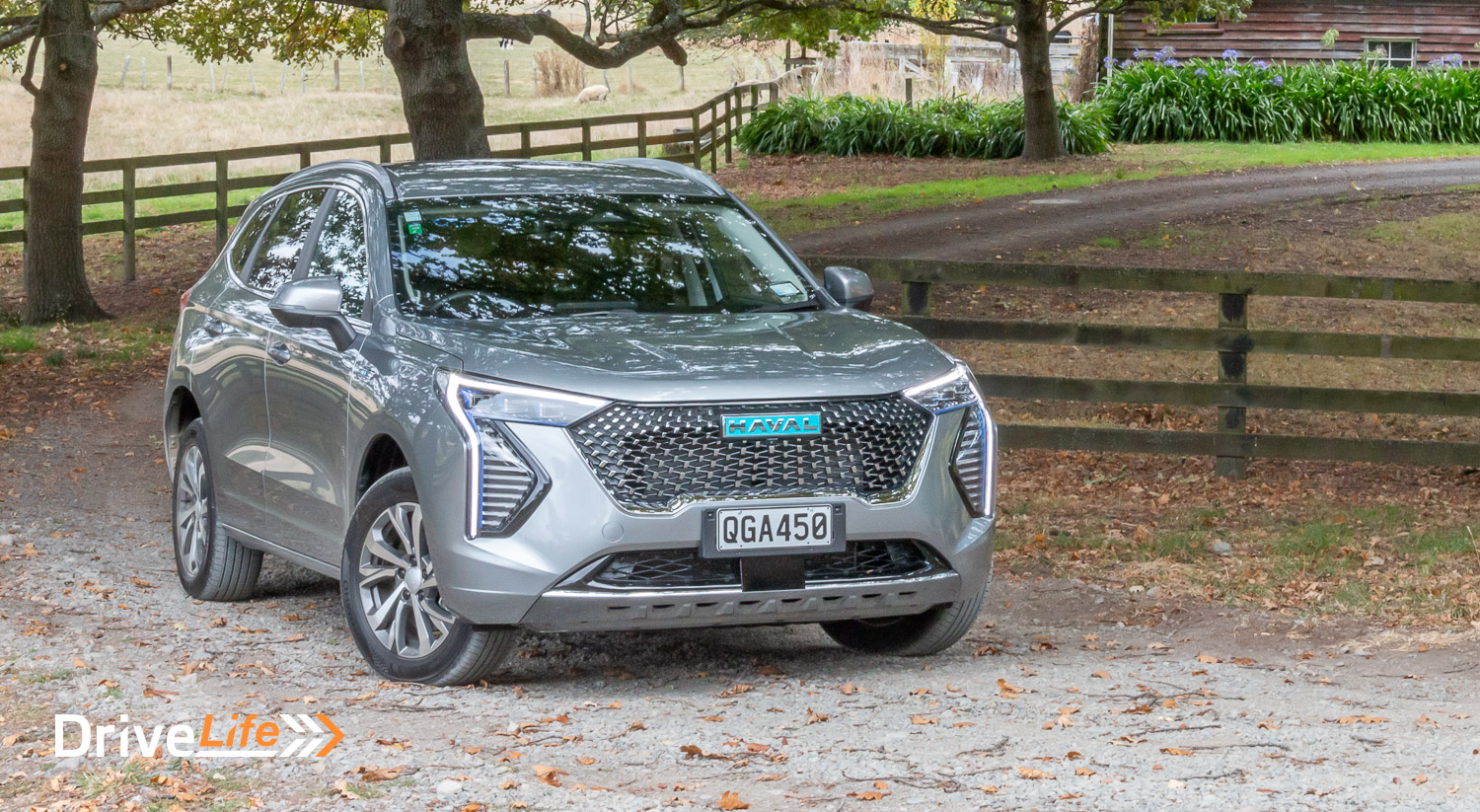
2023 GWM HAVAL JOLION LUX HYBRID – Specifications
| Vehicle Type | Small SUV |
| Starting Price | $35,990 |
| Price as Tested | $35,990 |
| Engine | 1.5-litre, 4-cylinder hybrid |
| Power, Torque kW/Nm | 139/375 (petrol-electric combined) |
| Transmission | Dedicated Hybrid Transmission (DHT) 2WD |
| Spare Wheel | Tyre repair kit |
| Kerb Weight, Kg | 1,530 |
| Length x Width x Height mm | 4,472 x 1,841 x 1,574 |
| Boot Space / Cargo Capacity, Litres (seats up/seats down) | 390/1,069 |
| Fuel tank capacity, litres | 55 |
| Fuel Economy, L/100km | Advertised Spec – Combined – 5.0 Real-World Test – Combined – 5.9 Low Usage: 0-6 / Medium Usage 6-12 / High Usage 12+ |
| Towing Capacity Kg, unbraked/braked | 750/1,300 |
| Turning circle metres | 11.5 Small: 6-10m / Medium 10-12m / Large 12m+ |
| Warranty | 7 years unlimited km warranty 8 years unlimited km battery pack warranty 5 years Roadside Assist |
| Safety information | ANCAP Rating – 5 stars Rightcar.govt.nz – 5 Stars – QGA450 |


